Great Wall Motors (GWM) has joined BYD by launching a plug-in hybrid 4×4 ute to the Australian market, but unlike the BYD Shark, the Cannon Alpha PHEV is a proper 4×4 with genuine off-road capability.
GWM has created its PHEV on the existing platform of the Cannon Alpha which is a slightly larger and better-equipped version of the Cannon ute. The Alpha is 5445mm long (35mm longer than Cannon Ute), 1991mm wide (57mm wider than Cannon Ute) and 1924mm high (38mm taller than Cannon Ute). The wheelbase of 3350mm is longer than that of a Cannon Ute by 120mm.
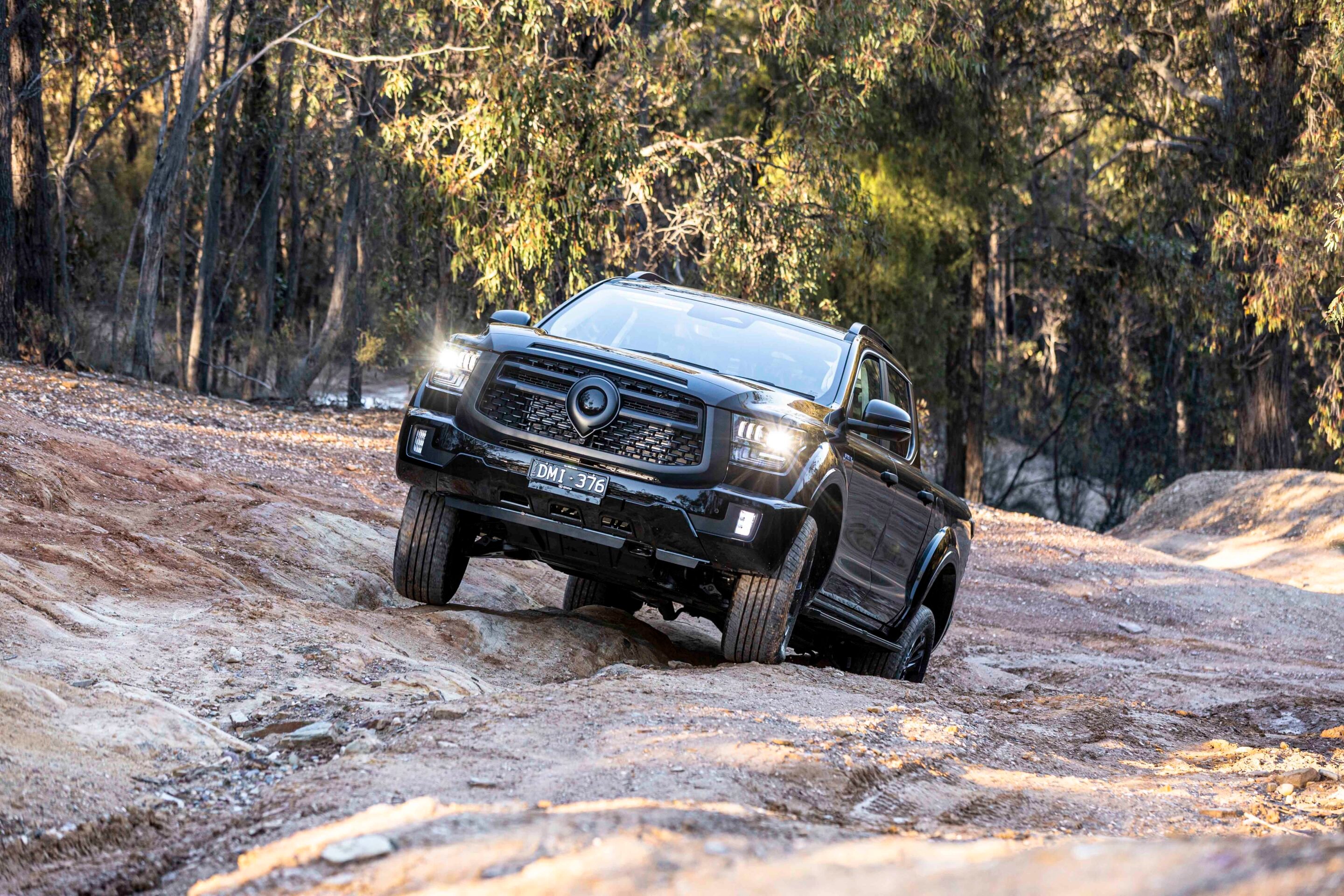
GWM released Australia’s first hybrid EV 4×4 ute in Australia in the middle of 2024 and this updated model is a plug-in version of that vehicle. GWM still offers the hybrid model as well as diesel-fuelled variants and now the PHEV. Two specification grades are offered – Lux and Ultra – and we have the Ultra PHEV on test here.
The big difference between the GWM and BYD utes is that the Cannon Alpha has a more conventional drivetrain with a nine-speed automatic transmission, dual-range transfer case and a tailshaft leading back to a live rear axle. In the case of the BYD Shark 6 the only connection between the front and rear axles is electronic – there is no mechanical connection – which limits its off-road ability.
JUMP AHEAD
Powertrain
The Cannon Ultra PHEV driveline comprises a turbocharged 2.0-litre petrol engine and an electric motor that is located within the transmission bell-housing along with the torque converter. Combined they deliver an output of 300kW and 750Nm and this is fed to a dual-range, on-demand 4×4 system.
The ICE engine makes 180kW and 380Nm on its own but when combined with the electric motor produces outputs exceeding that of most conventional ICE powered 4×4 utes. On and off road, the combined output gives the GWM impressive acceleration despite its 2800kg weight. Torque is king and the Cannon launches like it was shot out of an… umm, cannon. It even has a specific launch mode for quick getaways after you’ve waded through the menus to find and engage it.
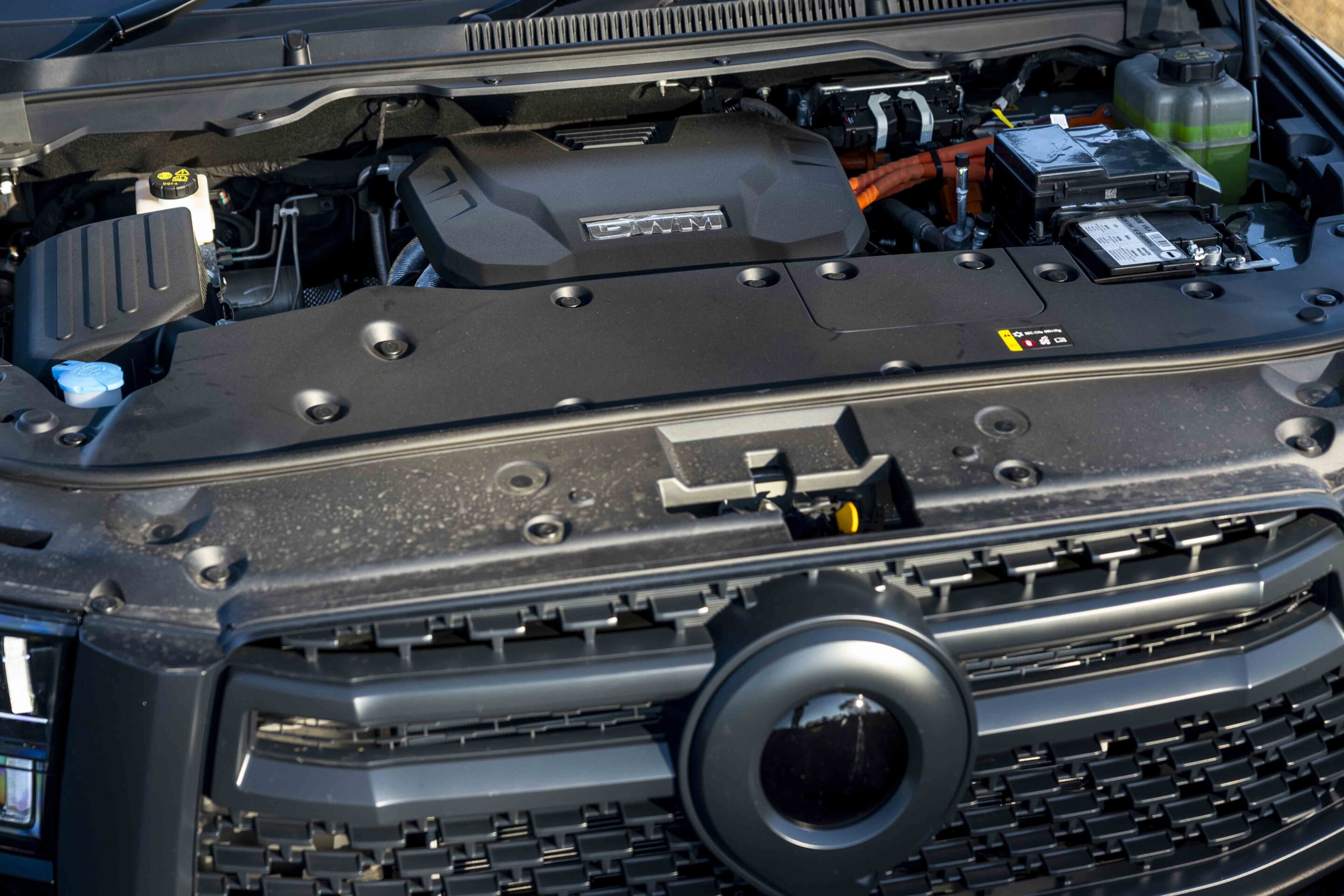
GWM claims that the Cannon Ultra has an EV range of 115km and a combined ICE and EV touring range of 1060km utilising the 75-litre petrol tank. The system has multiple modes to prioritise drive to your conditions with EV priority, full EV and intelligent modes.
Charging times from a DC charger are claimed to be 24 minutes from 30-80 per cent charge. There’s comprehensive info on the multimedia screen on the charging status and time, and you can also check it remotely via the GWM app. Filling the fuel tank with petrol is always simple and quick.
On the road
The Cannon’s acceleration is brisk, but you do feel its heft. Once up to speed it cruises smoothly and quietly whether in EV mode or when the ICE unit is in operation. An annoyance I found was the way the vehicle decelerates so much whenever you lift off the accelerator. This is because of the regenerative charging action of the hybrid powertrain , but if I wanted the Cannon to slow so much I’d use the brakes and not have the system doing it for me.
A further annoyance is the driver monitor that constantly harangues you. You can disable it, but again you have to go through the screen menus every time you start the vehicle to shut it up. On gravel surfaces the Ultra rides nicely over small corrugations and ruts inspiring confidence in the chassis and handling. It’s firm while still compliant enough to provide a comfortable ride.
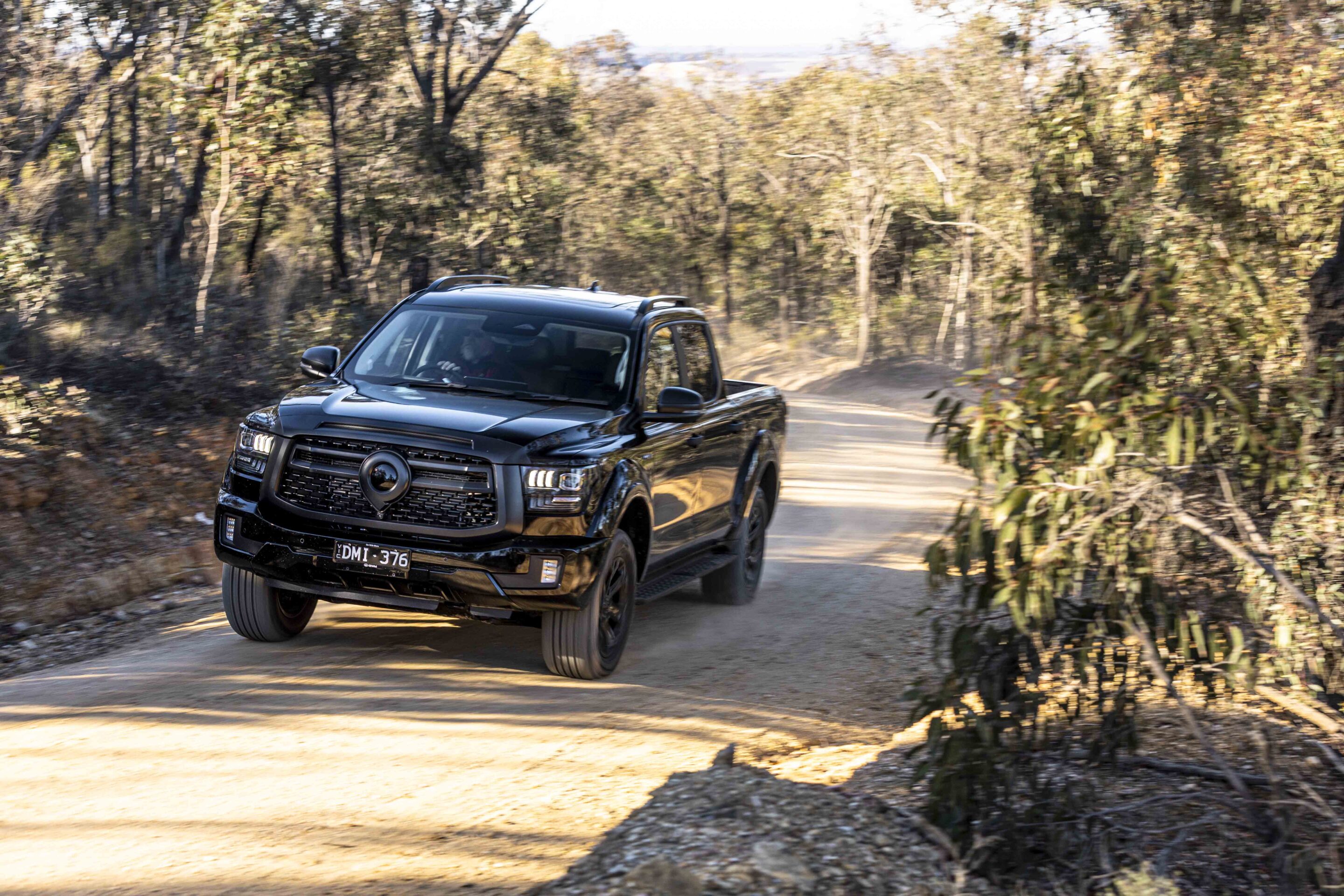
Off the road
Off road and in low range the ute makes easy work of uneven terrain and lifting wheels are countered by fast-acting ETC without having to engage the Ultra’s front and rear locking diffs. That’s right – the Cannon Alpha has front and rear lockers standard from the factory, something you can only find in a Ranger Raptor elsewhere in the midsize ute class. The ETC is a bit noisy in its operation and not as smooth as the best systems out there but it gets the job done.
The wishbone front end has the usual IFS limitations causing the aforementioned wheel lift while the leaf-spring live-axle rear articulates okay, if not amazingly. Combined with the front and rear lockers, the overall off-road package of the Cannon Alpha is pretty impressive.
| Off-road specs | |
|---|---|
| Approach angle | 28.5 |
| Ramp-over angle | 19 |
| Departure angle | 23 |
| Ground clearance | 210mm |
| Wading depth | 800mm |
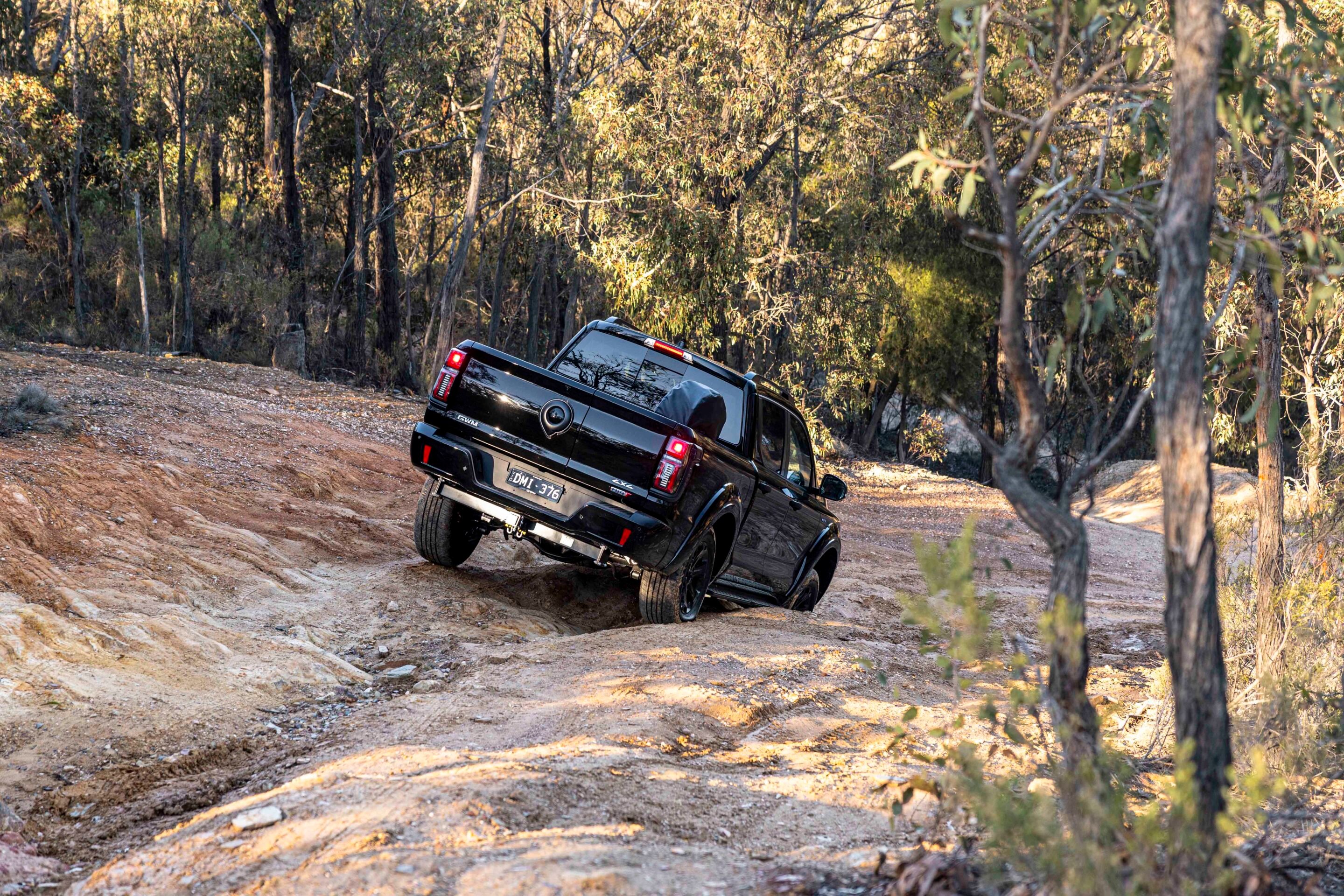
Interior
Also impressive is the array of standard equipment inside this ute. The 14.6-inch infotainment screen takes pride of place in the centre of the dash and is both big and easy to see and use. It is home to all the usual system settings, controls, Apple Carplay and Android Auto mirroring functions.
Unfortunately the only volume adjustment is via a slow-acting toggle on the steering wheel and the cabin temperature adjustment is all within the screen. This is annoying and somewhat dangerous as, if you like me, you drive with Carplay on most of the time, to adjust the cabin temperature you need to go into another menu, find the appropriate control and make the adjustment. When doing this the driver monitoring system will tell you to pay attention to driving and drive carefully, which is super annoying.
The Napa leather-covered seats are ventilated, heated front and rear with massaging on the front pews. The rear seats also have an electric slide and recline function that reduces the angle of the upright backrest that is customary in double-cab utes however, if a tall driver has his/her seat all the way back, it doesn’t leave a lot of space for the seat behind to slide forward and recline. But even in a normal, upright position there’s plenty of leg and headroom in the back for most passengers.
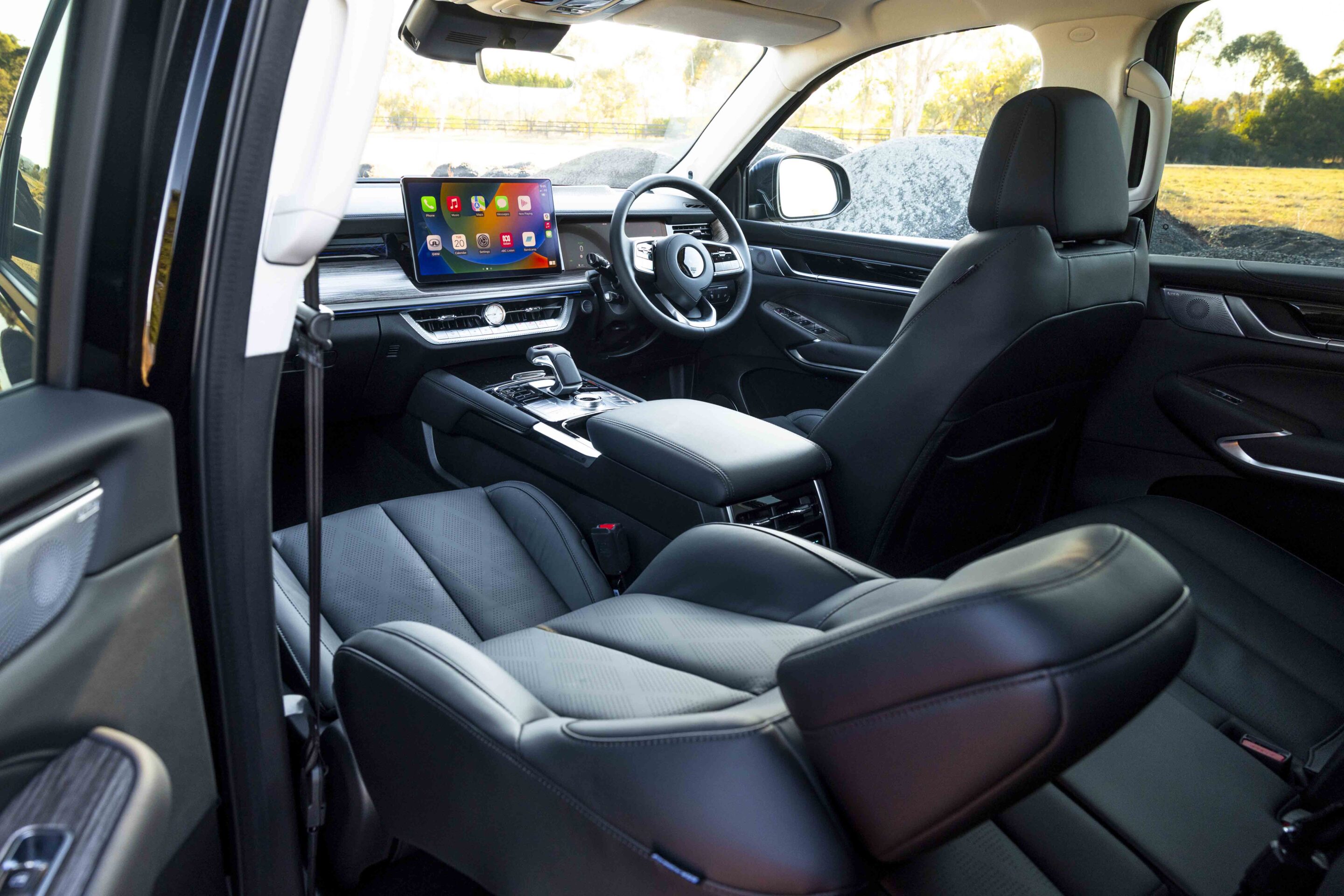
How practical is it?
Like the locking diffs, the level of features in the Ultra is a rare find in the midsize ute segment and one that is appreciated. Also appreciated is the large cargo tub that has a unique tailgate setup that can be opened in the traditional drop-down manner or swing-out via a vertical split.
The tub offers 1100mm between the wheel arches but in the PHEV, the spare wheel is mounted in the tub as the EV battery pack takes up the space below the tub where the spare would normally reside. There’s also a power outlet in the back to run power tools and accessories off the Cannon’s battery. On our drive, the vinyl cover over the spare tyre kept blowing off so we ended up removing it all together.
Important for many users is towing capacity and the Cannon PHEV retains the non-EV model’s 3500kg maximum braked towing capacity. Not so good is the 685kg payload which means that owners will have to be cautious with how much they load into their Cannon, especially if they have anywhere near the maximum 350kg on the towbar.
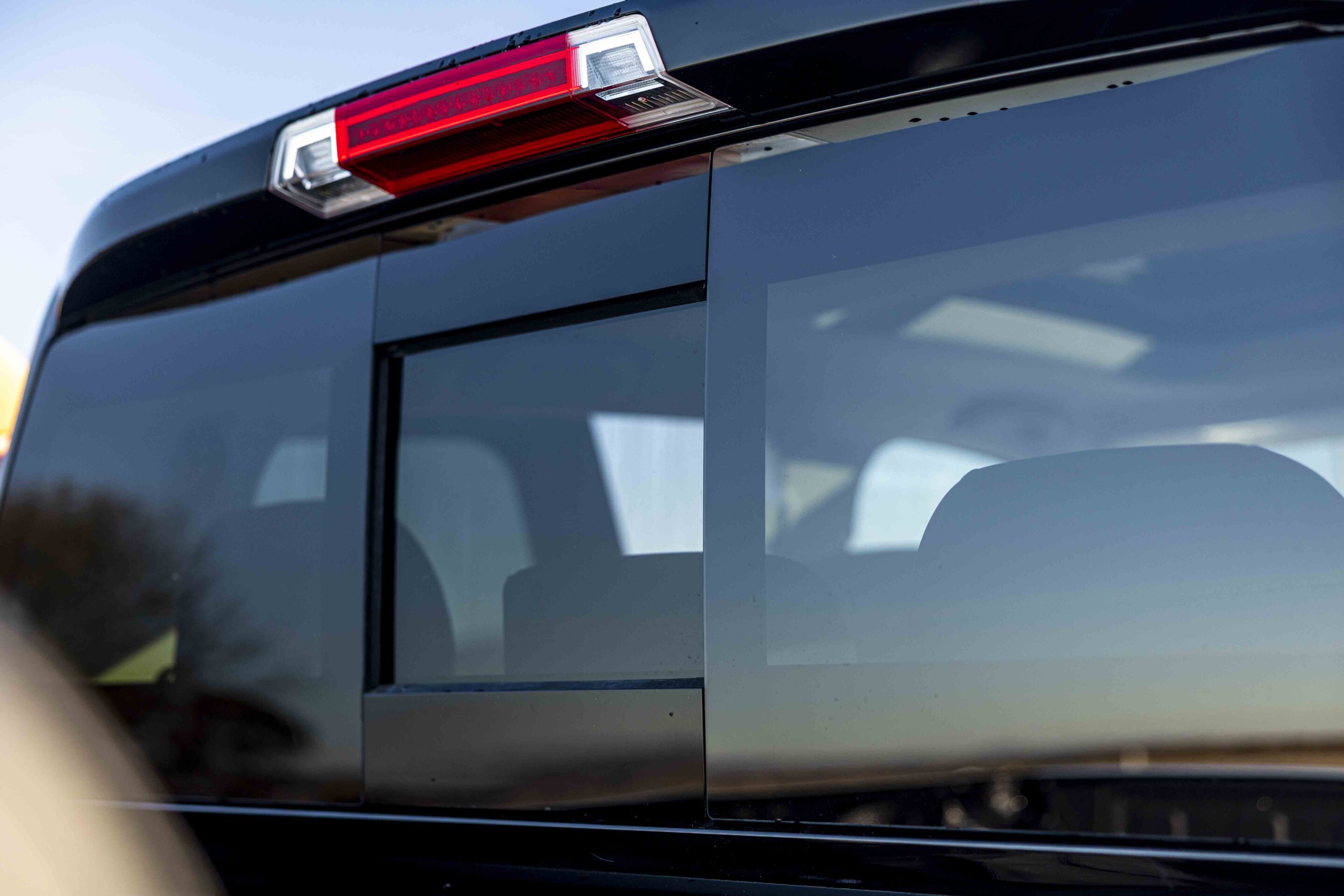
Safety and warranty
The Cannon Alpha has all the standard ADAS and safety features needed to give it a 2025 five-star ANCAP rating. It’s just a shame that the driver monitor system is so intrusive and annoying.
The GWM comes with a seven-year factory warranty, seven-year roadside assistance and capped-price servicing, and an eight-year warranty on the lithium EV battery pack.
Verdict
The GWM Cannon Alpha PHEV gives buyers wanting an electrified ute an option that delivers hybrid fuel efficiency with genuine off-road capability in a luxurious and spacious vehicle for a very attractive price and ownership package.
It’s a package that hasn’t been available in Australia until now, and until we spend some time in the Ranger PHEV, it offers the best all-round combination of all the key elements; this is especially so in the top-spec Ultra trim with the $67k price. For reference, the Ford Ranger PHEV will start at $72k and go up to $87k for the top-spec model.
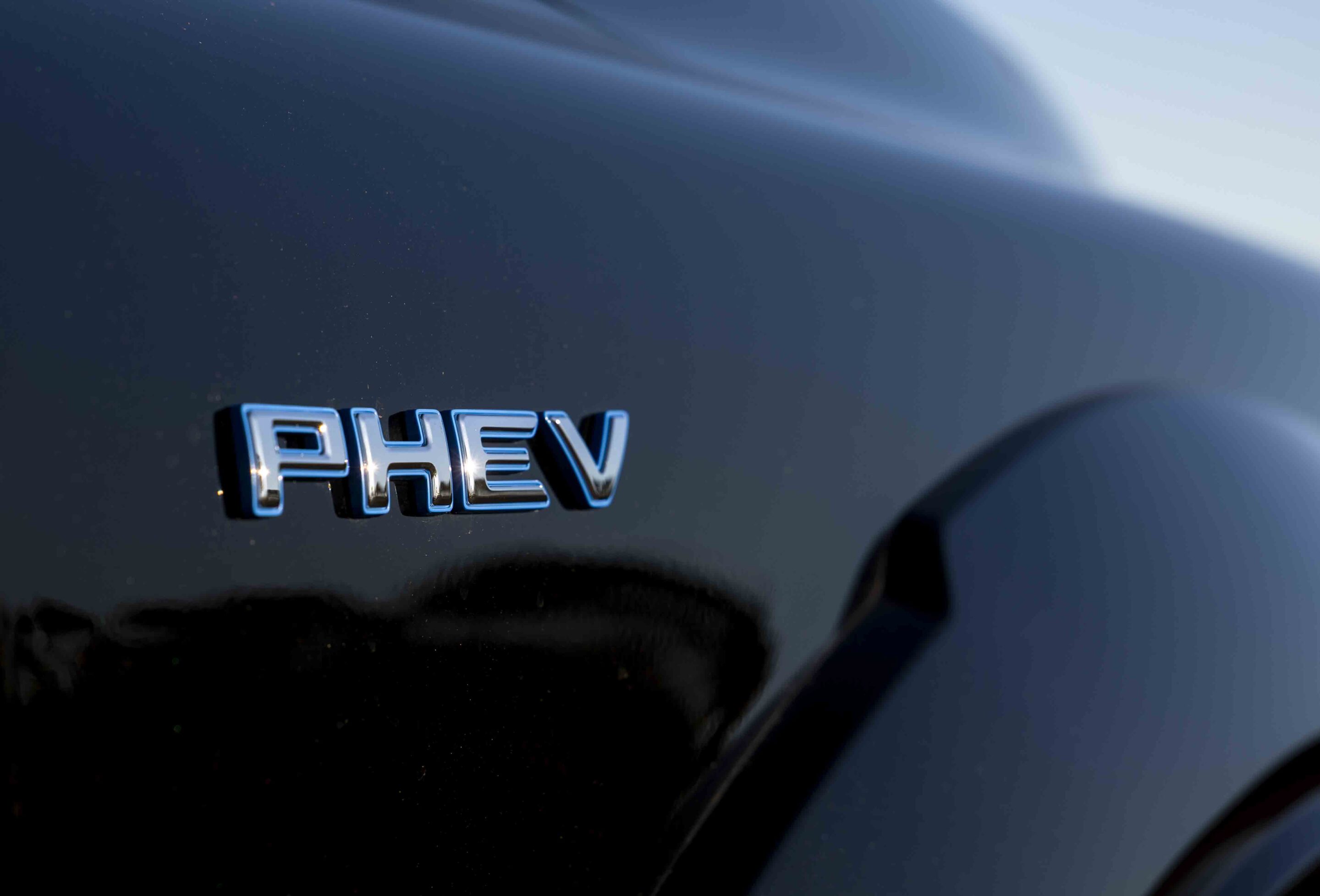
Specs
| GWM Cannon Alpha PHEV specs | |
|---|---|
| Price | $66,990 |
| Engine | Petrol ICE with electric motor |
| Capacity | 2.0L |
| Max power | 300kw (combined) |
| Max torque | 750Nm (combined) |
| Transmission | 9-speed automatic |
| 4×4 system | On demand/dual range |
| Construction | 4-door ute on ladder frame chassis |
| Front suspension | IFS, double wishbones, coil springs |
| Rear suspension | Live axle with leaf springs |
| Tyres | 265/60R18 on alloy wheels |
| Kerb weight | 2810kg |
| GVM | 3495kg |
| GCM | 6745kg |
| Towing capacity | 3500kg braked |
| Payload | 685kg |
| Seats | 5 |
| Fuel tank | 75L |
| ADR fuel consumption | 1.7L/100km combined hybrid |
Ford has added a plug-in hybrid to its top-selling ute range, and the Ranger PHEV is more than just a fuel-saver – it’s a refined, powerful and highly capable dual-cab ute that is effective for work, touring and off-road conditions.
At the heart of the new model is a 2.3-litre turbocharged four-cylinder petrol engine paired with a 75kW electric motor and an 11.8kWh battery. On its own, the 2.3-litre petrol engine makes a claimed 138kW at 4600rpm and 411Nm at 2700rpm, but combined output is a stout 207kW at 4600rpm and 697Nm at 2500rpm, fed through a 10-speed Modular Hybrid Transmission (MHT) and a full-time 4×4 system lifted from the Ranger Raptor. This includes a locking rear diff, low-range and an Auto 4WD setting that works well on mixed terrain.
Ford claims 2.9L/100km combined fuel consumption under lab testing, and a battery-only range of 45km (WLTP), but on our real-world drive – starting in Auto EV mode – we covered around 27km on battery alone before the battery was depleted and the petrol engine took over. Over a 60km mixed loop, our average fuel consumption was 6.9L/100km, which is still impressive for what is a fairly large dual-cab ute with serious off-road chops. A regenerative braking system helps charge the battery which aids efficiency in stop-start driving scenarios; there is an EV Coach in the instrument cluster aimed at helping drivers make the most of the system.
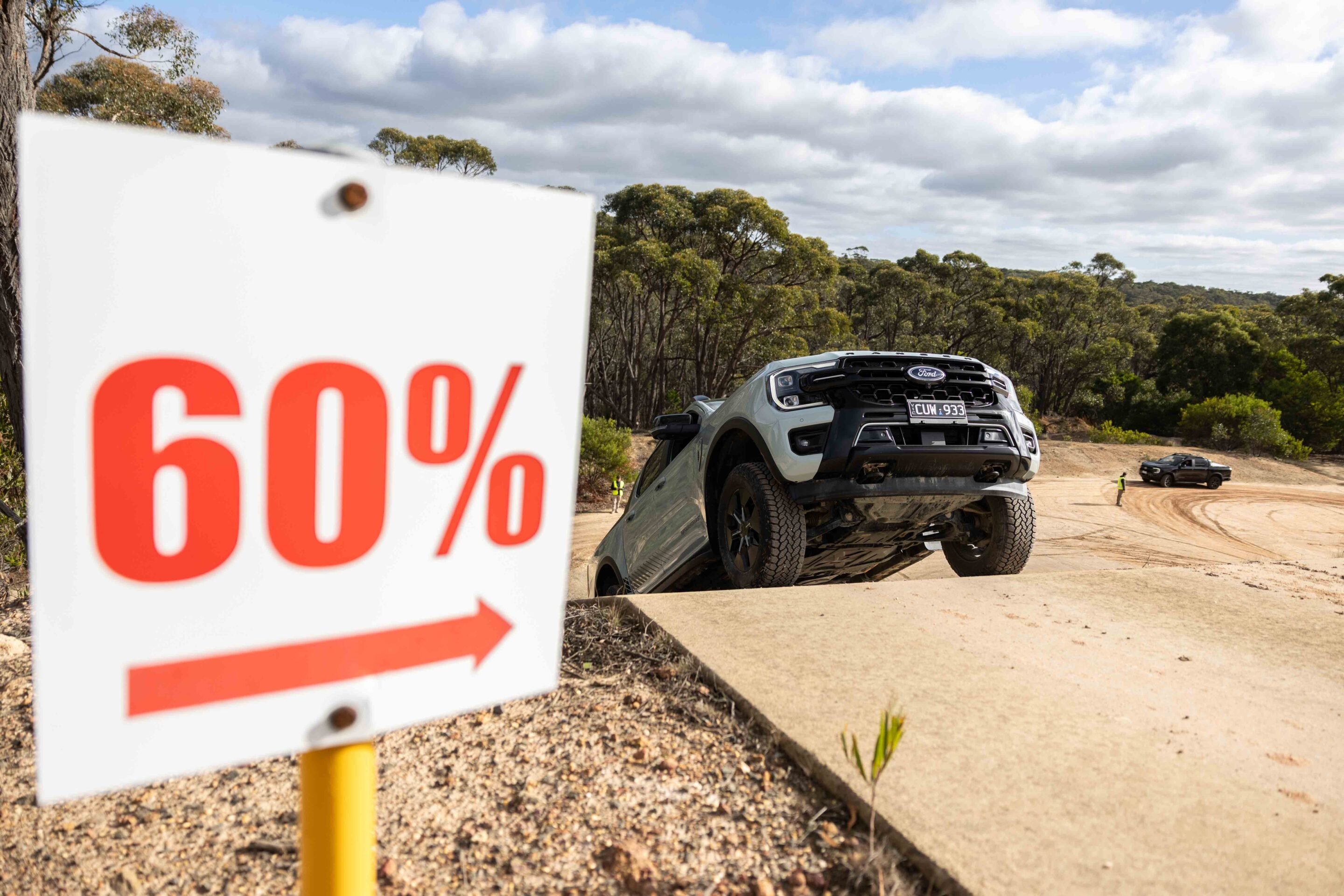
The addition of the battery and electric motor system means the Ranger PHEV is significantly heavier than its diesel siblings, with kerb weights ranging from 2527kg in the XLT to 2692kg in the fully optioned Stormtrak – around 240-400kg heavier than an equivalent 3.0L V6 diesel model. That extra weight eats into payload, with figures dropping as low as 808kg in the Stormtrak.
It should also be noted that the quoted payload figures are without the spare wheel/tyre hanging under the tub, as this vital component is now offered as a no-cost option; we can’t help but think the reason for this is down to marketing as the deletion of the spare as standard equipment means around 20kg can be added to the payload figure across the range. While still capable of towing a 3500kg braked trailer, prospective owners will need to pay close attention to gross vehicle mass (GVM) and payload calculations if loading the tub or hitching up a heavy trailer.
JUMP AHEAD
Model range
The Ranger PHEV is available in four trim levels – XLT, Sport, Wildtrak and Stormtrak – with drive-away pricing ranging from $71,990 to $86,990.
The XLT offers the essentials, including full-time 4×4, selectable EV drive modes, and Pro Power Onboard with up to 6.9kW of AC output. Stepping up to the Sport ($75,990 drive-away) adds leather-accented trim, heated seats, wireless charging and LED lighting.
The $79,990 Wildtrak introduces matrix LED headlights, power roller shutter, unique styling and a 10-speaker B&O sound system. At the top of the range, the Stormtrak ($86,990 drive-away) includes exclusive Chill Grey accents, a flexible rack system, unique 18-inch wheels, and factory-fitted auxiliary switches for powering aftermarket gear.
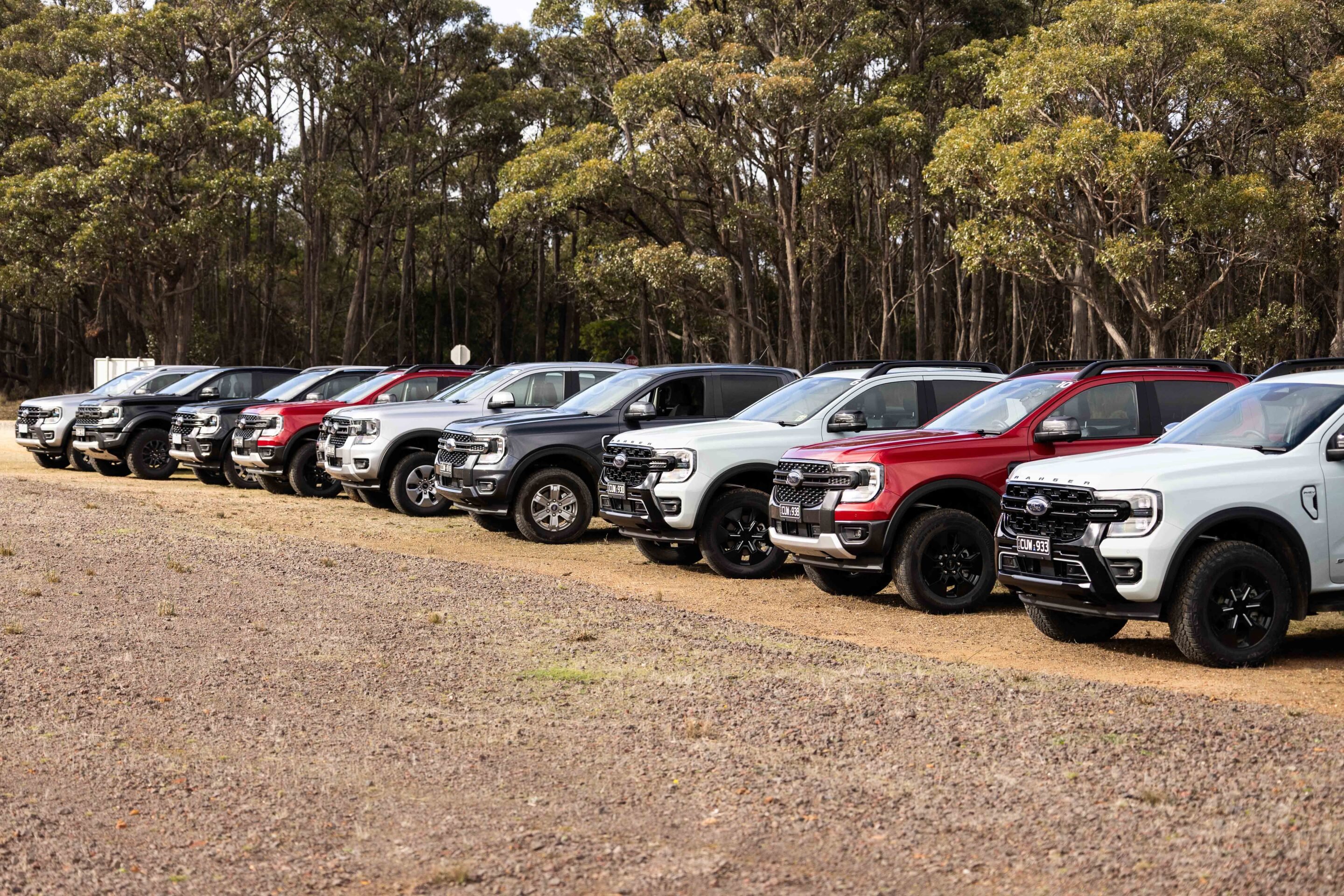
Power pack
Charging the Ranger PHEV is as easy as plugging in your smartphone.
The vehicle is supplied with a Mode 2 home charging cable and can be topped up overnight using a standard 240V wall socket. From empty to full, the 11.8kWh battery takes just under seven hours to charge on a 10A outlet, or around four hours on a 15A socket – ideal for those wanting to start the next day’s commute with a full charge and minimal fuel use.
The Ranger PHEV does not offer DC fast-charging, but if you’re away from a power source or just want to replenish the battery on the move, selecting EV Charge mode turns the petrol engine into a generator. This is ideal when you want to use the Ranger’s Pro Power Onboard system to run 240V appliances at a worksite or campsite – things like power tools, a bar fridge, a coffee machine or even a Travel Buddy oven. It also ensures you’ve got enough stored energy to charge up an electric bike or other kit when you arrive at your destination.
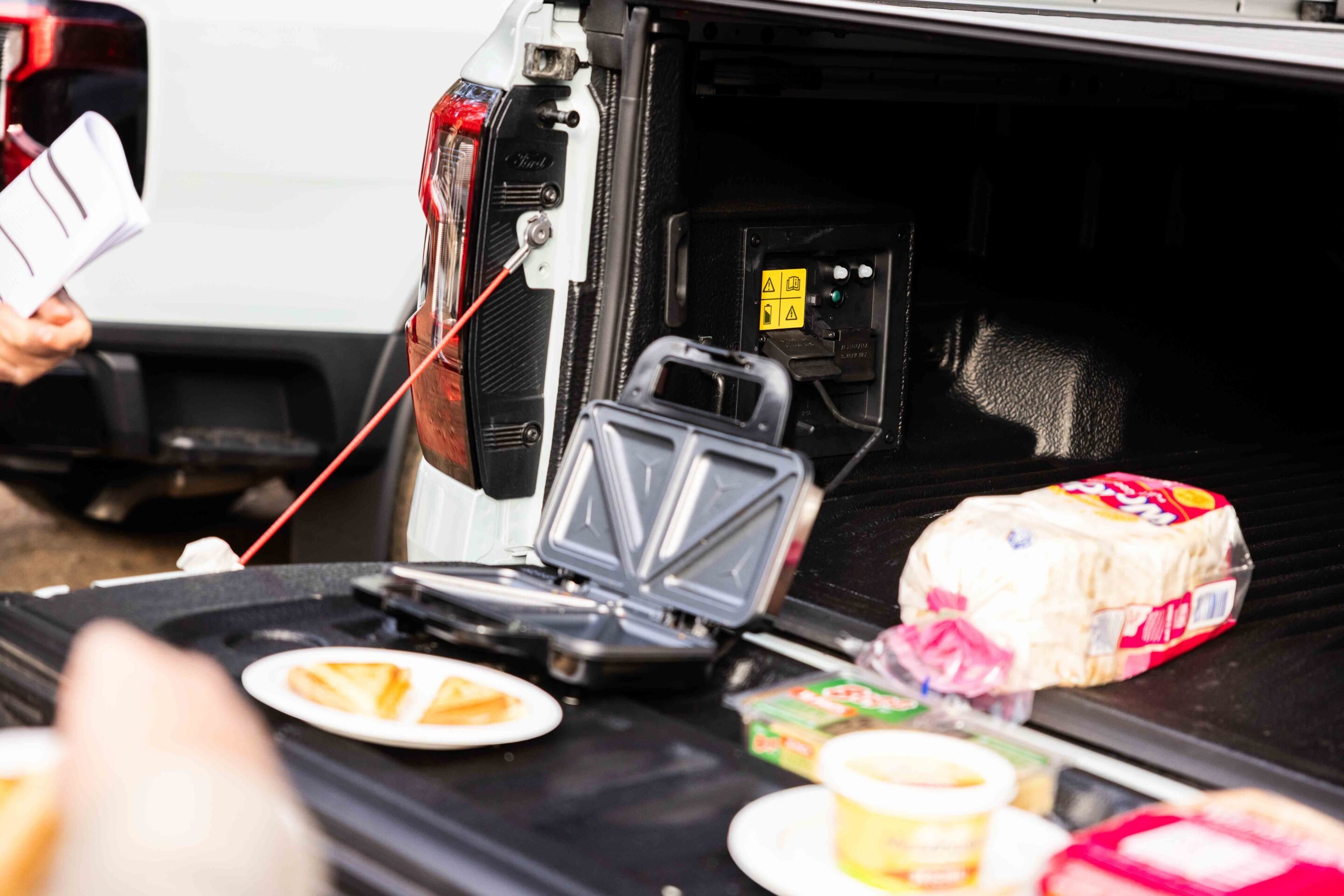
There are three AC power outlets; two 3.45kW (15A @ 230V) outlets in the tray and a 2.3kW (10A @ 230V) outlet in the cabin. Once the 11.8kWh battery is depleted, it can be recharged by simply firing up the engine and selecting EV Charge mode; Ford describes it as a portable generator with a 70-litre fuel tank.
Theoretically, if you were staying at the one campsite for an extended period, you could also charge the battery from solar panels, but you would need to use an inverter and charge through the standard AC input using the supplied Mode 2 home charging cable.
On the road
On bitumen, the Ranger PHEV feels more refined than its diesel siblings.
The petrol-electric drivetrain is smooth and quiet, with acceleration that easily rivals the V6 diesel. Put your foot down and this Ranger hauls. The electric motor fills in any gaps from the turbo-petrol engine and the result is strong, seamless torque delivery.
Even towing a 2.8-tonne trailer and digger combo, the PHEV felt untroubled. While we didn’t record fuel figures during towing, it’s clear the hybrid system helps with low-speed grunt, making for effortless take-offs and confident hill starts. There’s also a Pro Trailer Back-up Assist system on Wildtrak and Stormtrak model grades, with a dial in the centre console to aid reversing with a trailer attached.
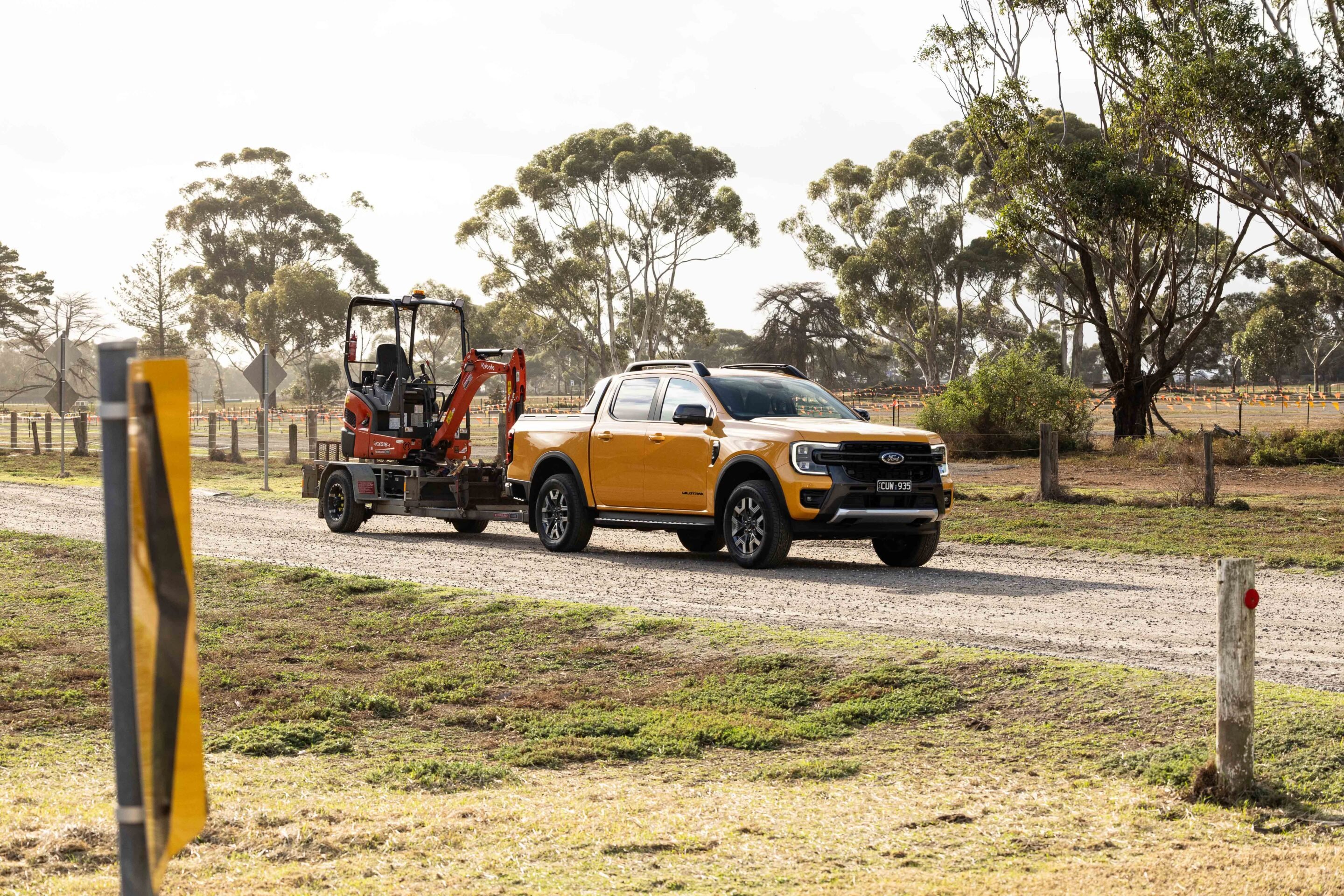
Handling is well sorted too. Steering is nicely weighted, body control is tight, and unladen ride quality is good. The Ranger PHEV is heftier than its diesel counterparts and much of this weight (the battery) is towards the rear of the vehicle, and this no doubt helps to settle the rear end when driving over bumpy roads. Lane-keep assist works unobtrusively and, unlike some rivals, there’s no incessant beeping.
The hybrid system offers four drive modes: Auto EV, EV Now, EV Later and EV Charge. In EV Charge mode – which uses the engine to replenish the battery – we recorded 9.6L/100km on a highway leg, and it would take around two hours of driving to fully charge from empty. This was on a vehicle equipped with optional General Grabber A/T rubber (255/65R18), so you could eke out a bit more fuel economy if you were on the standard Continental ContiCrossContact H/T tyres. Regardless, with a 70-litre tank, the theoretical touring range on the open road is more than 700km.
Speaking of the open road, Ford Australia was at pains to point out that it has the second-largest dealer network in the country; a subtle dig, no doubt, at the new Chinese players on the market that are eating into the market share of traditional nameplates.
Off the road
We tackled a few off-road challenges on the launch drive, including a short run on a tricky track in Lerderderg State Park on Day 1 and several off-road courses at the Australian Automotive Research Centre (AARC), a facility that 4X4 Australia has used previously for 4X4 Of The Year testing.
Like other Rangers, the PHEV variants feature driver-selectable modes (Normal, Eco, Tow/Haul, Slippery, Mud/Ruts, Sand and Sport) in addition to its EV Drive modes. The track in Lerderderg was steep and slippery in places and was good for testing the effectiveness of the Ranger PHEV’s drive modes, low-range gearing, rear diff lock, traction control, ground clearance and off-road angles. If you are familiar with the performance of a diesel Ranger off road, this will give you a fair idea of how the Ranger PHEV performs, which is to say it’s an impressive bit of kit.
On the test loop at the Australian Automotive Research Centre, the Ranger PHEV clambered up 60 per cent grades in 4 Auto mode using EV power only. The petrol engine only joined in when needed, doing so quietly and smoothly. In really tricky situations you would obviously select low range and lock the rear diff, in which case the petrol engine would automatically fire up.
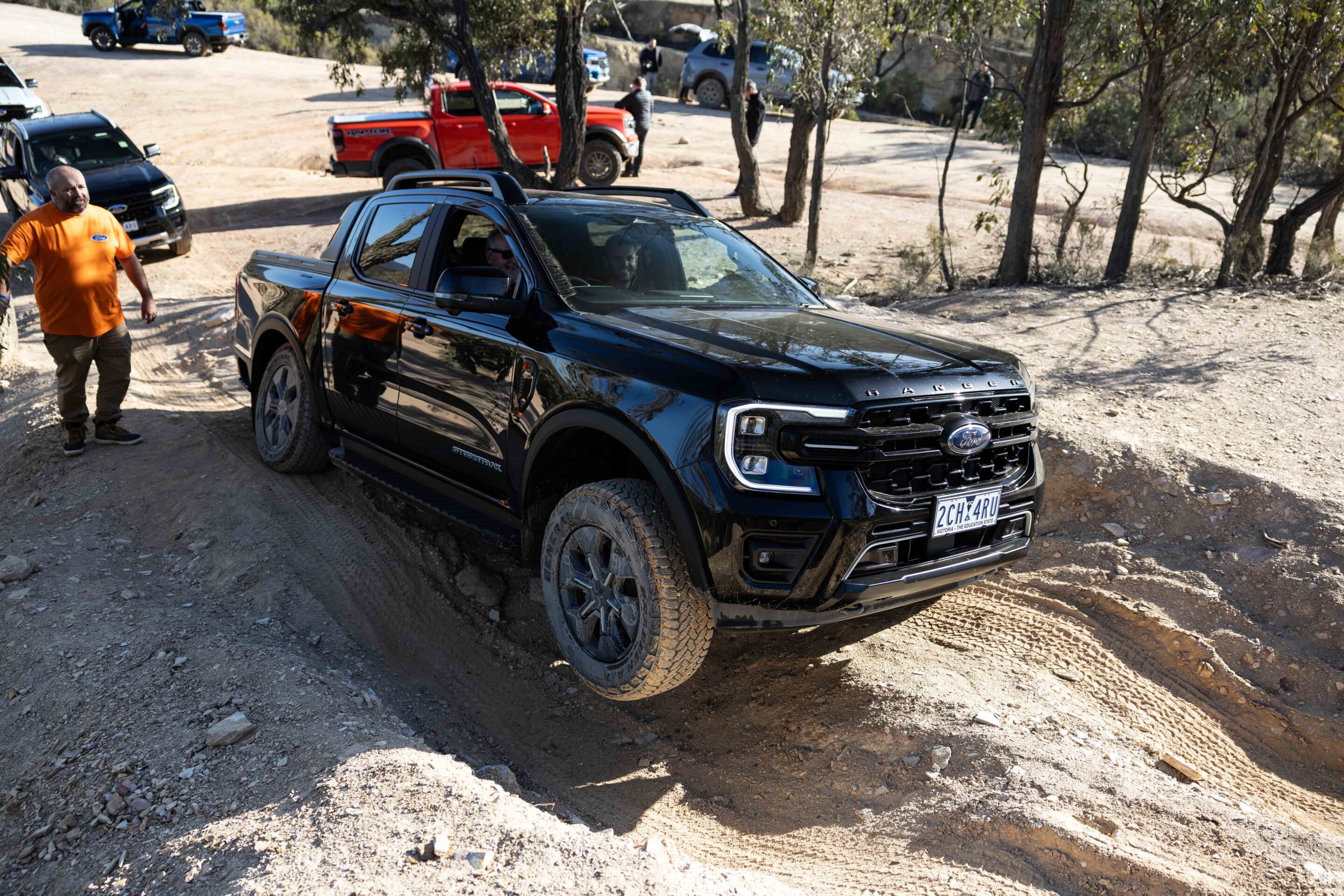
Hill Descent Control is excellent. Speed is adjustable in 1km/h increments via the cruise control buttons, and the system works quietly, without the whirring of older-generation systems. Forward camera vision is great for cresting hills, and Ford has thoughtfully added a washer jet to keep it clean.
Like other Rangers, wading depth is quoted at 800mm. It should be noted that the engine air intake is forward facing just below the lip of the bonnet, so fitment of a snorkel would be a good idea for 4×4 touring.
There’s a unique joy to off-roading in near silence. With the windows down and the electric motor engaged, you hear only tyres on gravel and the sounds of birds and bush. It’s an entirely entertaining way to experience a track, and even when the electric engine kicks in, the Ranger PHEV is still quieter than the diesel variants, and it’s this refinement that many buyers will find attractive.
| Measurement | Value |
|---|---|
| Approach Angle | 28.9 – 30.2 |
| Ramp Over Angle | 19.6 – 20.4 |
| Departure Angle | 23.9 – 24.7 |
| Ground Clearance | 215 – 228mm |
| Wading Depth | 800mm |
Interior and exterior
Step inside and the Ranger PHEV feels familiar.
The interior mirrors that of the diesel Ranger, which means good ergonomics, supportive seats and a massive 12-inch portrait centre screen that thankfully retains physical dials for volume and climate control, making on-the-fly adjustments easier than systems buried entirely in menus.
New features include a dash-mounted button to open the fuel filler (necessary for the pressurised fuel system) and a charging port with a locking function on the passenger side.
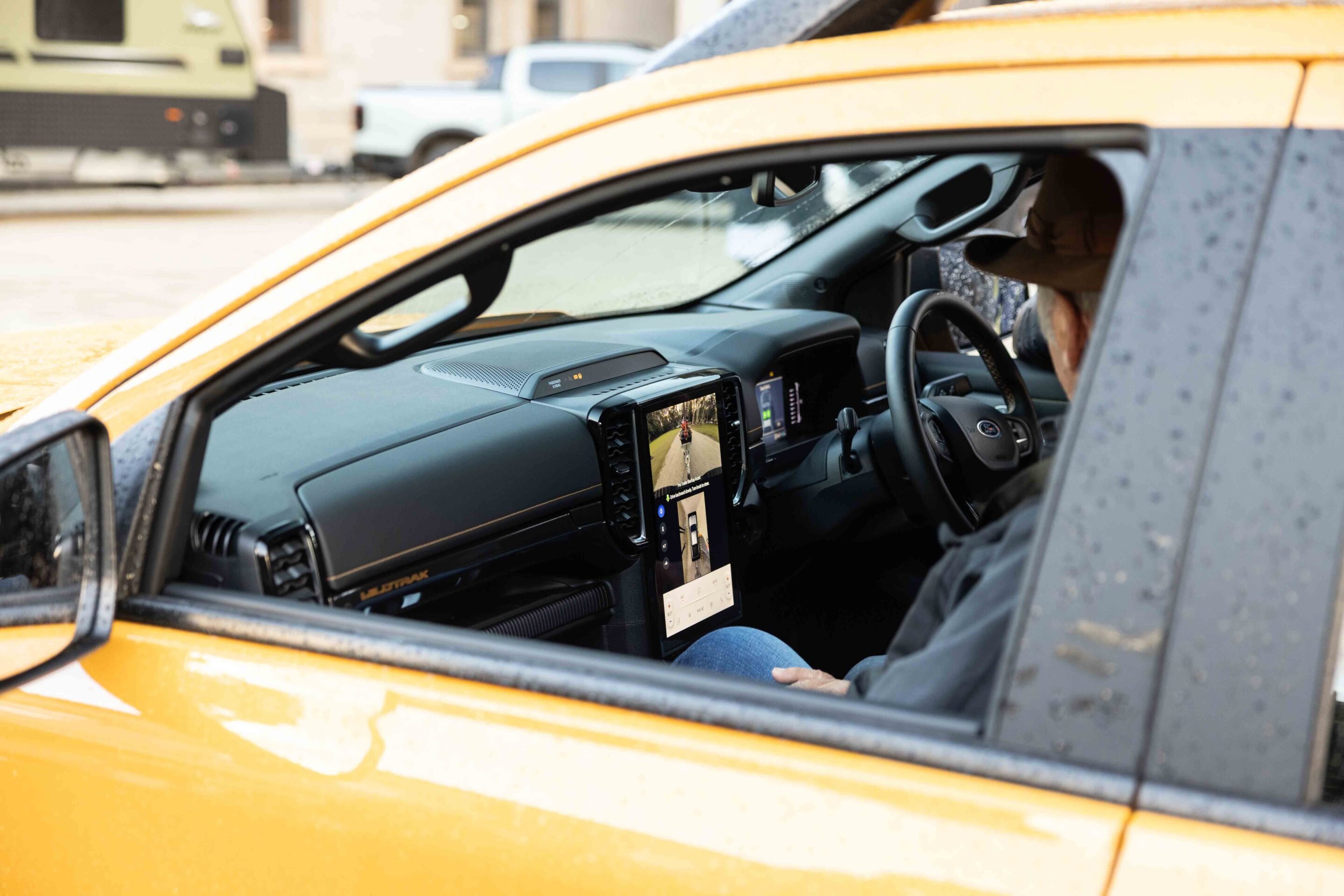
Out the back you can’t remove the tub to fit a tray or canopy – the location of the battery, the integrated wiring and the 240V outlets rule that out – but the tub is otherwise well set up. There are cut-outs in the tub liner to accommodate long items, while a pair of adjustable top-rail tie-downs and a 31mm raised bed floor (to accommodate the battery) distinguish it from other Ranger trays.
Underbody protection has been fitted to prevent damage to the battery pack when driving off road, but take a peek beneath the passenger-side sill and you’ll spot an orange electrical conduit mounted on the outside of the chassis rail, and while it doesn’t hang low, it looks like it could be vulnerable to debris strikes – a small guard here would be welcome.
Model line-up and pricing
XLT – $71,990 drive-away
- Full-time 4WD with EV drive modes
- 17-inch alloy wheels, halogen lighting
- Cloth trim, manual seats
- Pro Power Onboard (6.9kW max output)
- Rear diff lock
- Adaptive cruise control
Sport – $75,990 drive-away
Includes XLT features, plus:
- 18-inch alloy wheels, LED lighting
- Leather-accented trim with heated front seats
- Power-adjustable driver’s seat
- Wireless charging
- Dark exterior accents
- Enhanced driver assist with Stop & Go
Wildtrak – $79,990 drive-away
Includes Sport features, plus:
- Matrix LED headlights
- Power roller shutter & roof rails
- Unique grille and sailplane design
- B&O 10-speaker premium audio system
- 360-degree camera
- Pro Trailer Backup Assist
Stormtrak – $86,990 Drive-Away
Includes Wildtrak features, plus:
- Chill Grey accents & exclusive wheels
- Flexible rack system and advanced cargo management
- Auxiliary switch bank (standard)
- Unique leather seats with Stormtrak trim
Specs
| Specification | Details |
|---|---|
| Price | $71,990 (XLT); $75,990 (Sport); $79,990 (Wildtrak); $86,990 (Stormtrak) |
| Engine | 2.3L turbo petrol four with 75kW electric motor |
| Capacity | 2.3L petrol + 11.8kWh battery |
| Max Power | 207kW (combined) |
| Max Torque | 697Nm (combined) |
| Transmission | 10-speed automatic |
| 4×4 System | Selectable full-time 4WD, dual-range |
| Construction | 4-door ute on ladder frame chassis |
| Front Suspension | Independent front suspension, double wishbones, coil springs |
| Rear Suspension | Live axle with leaf springs |
| Tyres | 17-18 inch (A/T optional) |
| Kerb Weight | 2527-2692kg |
| GVM (Gross Vehicle Mass) | 3500kg |
| GCM (Gross Combined Mass) | 6580kg |
| Towing Capacity | 3500kg |
| Payload | 808-973kg (no spare fitted) |
| Seating Capacity | 5 |
| Fuel Tank Capacity | 70L |
| ADR Fuel Consumption | 2.9L/100km (claimed) |
| On-Test Fuel Consumption | 8.3L/100km (predominantly highway; Auto EV/EV Charge modes) |
Verdict
Ford’s first plug-in hybrid ute is more than a stepping stone toward electrification – it’s a genuine dual-cab workhorse with real-world benefits.
Sure, it runs a much smaller-capacity battery than its obvious rivals, but the Ranger PHEV hauls, tows and climbs with ease. It brings strong performance, low fuel use and added refinement over diesel models, while keeping all the off-road gear intact.
While it doesn’t have quite the same electric-only range as some competitors, it makes up for it with a proper mechanical 4×4 system, full towing capacity (3500kg) and a well-integrated hybrid driveline. The onboard Pro Power system adds serious appeal for campers and tradies needing AC power on the worksite or at the campsite.
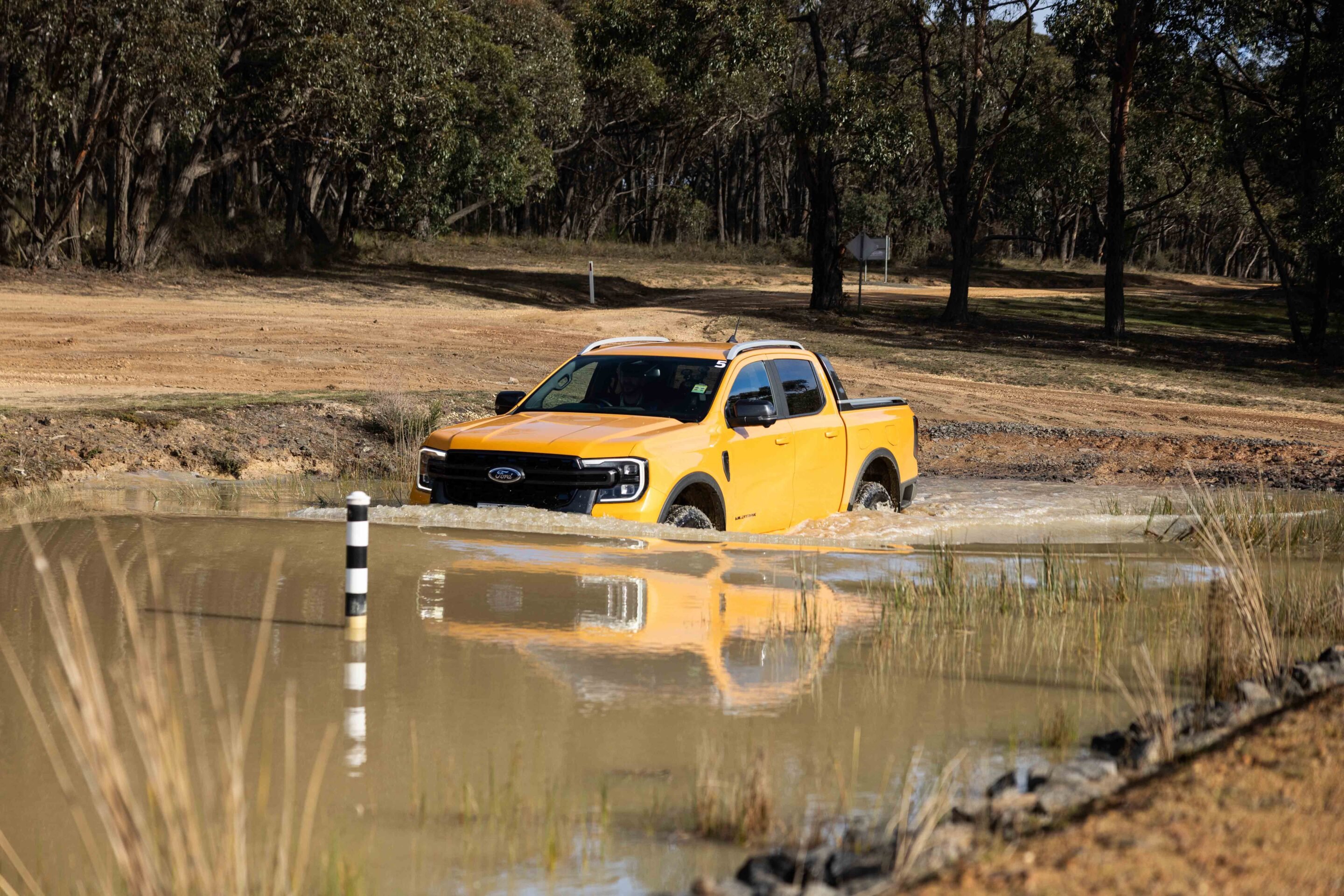
Until full electric utes catch up on range, and a comprehensive nation-wide charging infrastructure is in place, the PHEV powertrain looks to be the sweet spot – and Ford’s execution of it in the Ranger is very well resolved.
Of course, the Ranger PHEV will not be for everyone, particularly those who want to fit a tray or canopy, but despite not having the electric range of some of its competitors, including the new GWM Cannon Alpha, there’s no doubt Ford has done its homework and has developed a compelling hybrid ute for those looking at an alternative to diesel ute offerings.
GWM has given the Tank 500 a facelift, unveiling a redesigned front grille aimed squarely at Australian buyers.
“This update reflects Australia’s influence in shaping the vehicle to better align with local consumer preferences,” the brand said in a statement.
The refreshed front end is bolder than before, featuring fewer horizontal slats while retaining a strong chrome presence. Despite the cosmetic changes, the Tank 500 continues to hold a five-star ANCAP safety rating.
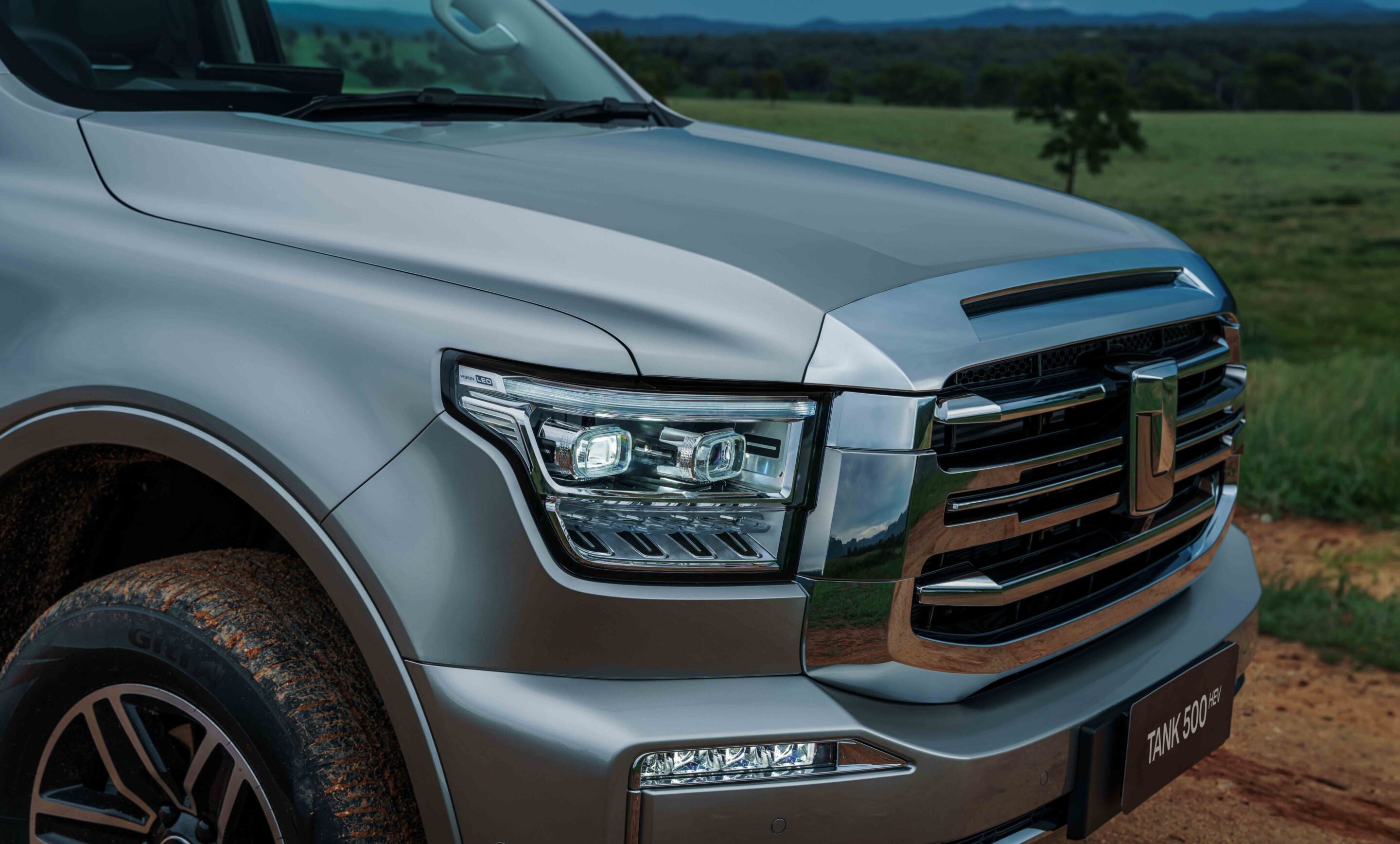
The new grille is part of a broader series of updates rolled out over the past 12 months. These include locally tuned suspension for improved ride and handling, and software enhancements – most notably to the adaptive cruise control system – to further refine its on-road performance.
The Tank 500 remains a well-equipped, three-row, seven-seat large 4×4 SUV that delivers strong value against higher-priced rivals like the Toyota LandCruiser 300 Series. It comes in two variants – Luxury and Ultra – both powered by a 2.0-litre turbocharged petrol-electric hybrid producing 255kW and 642Nm, paired with a nine-speed automatic transmission. Off-road capability is bolstered by front, centre, and rear locking differentials.
Production of the updated Tank 500 began in April 2025.
GWM has successfully beaten one of Australia’s most infamous off-road challenges: Beer O’Clock Hill.
A total of three GWM vehicles – the Cannon Alpha PHEV, Cannon XSR diesel and Tank 300 diesel – reached the summit in a show of strength for GWM, a brand out to prove it should no longer be underestimated when the going gets rough. All three of the vehicles were essentially showroom-stock – the XSR wearing factory tyres; the Cannon Alpha shod in Mickey Thompson Baja Boss all-terrains.
By reaching the summit, the Cannon Alpha PHEV made history by becoming the first PHEV of any kind to ascend Beer O’Clock Hill. Powered by GWM’s Hi4-T platform, the system combines a 2.0-litre turbocharged petrol engine (180kW/380Nm) with a 120kW electric motor (400Nm) to deliver a combined output of 300kW and 750Nm. It uses a nine-speed hybrid automatic transmission with full-time 4WD.
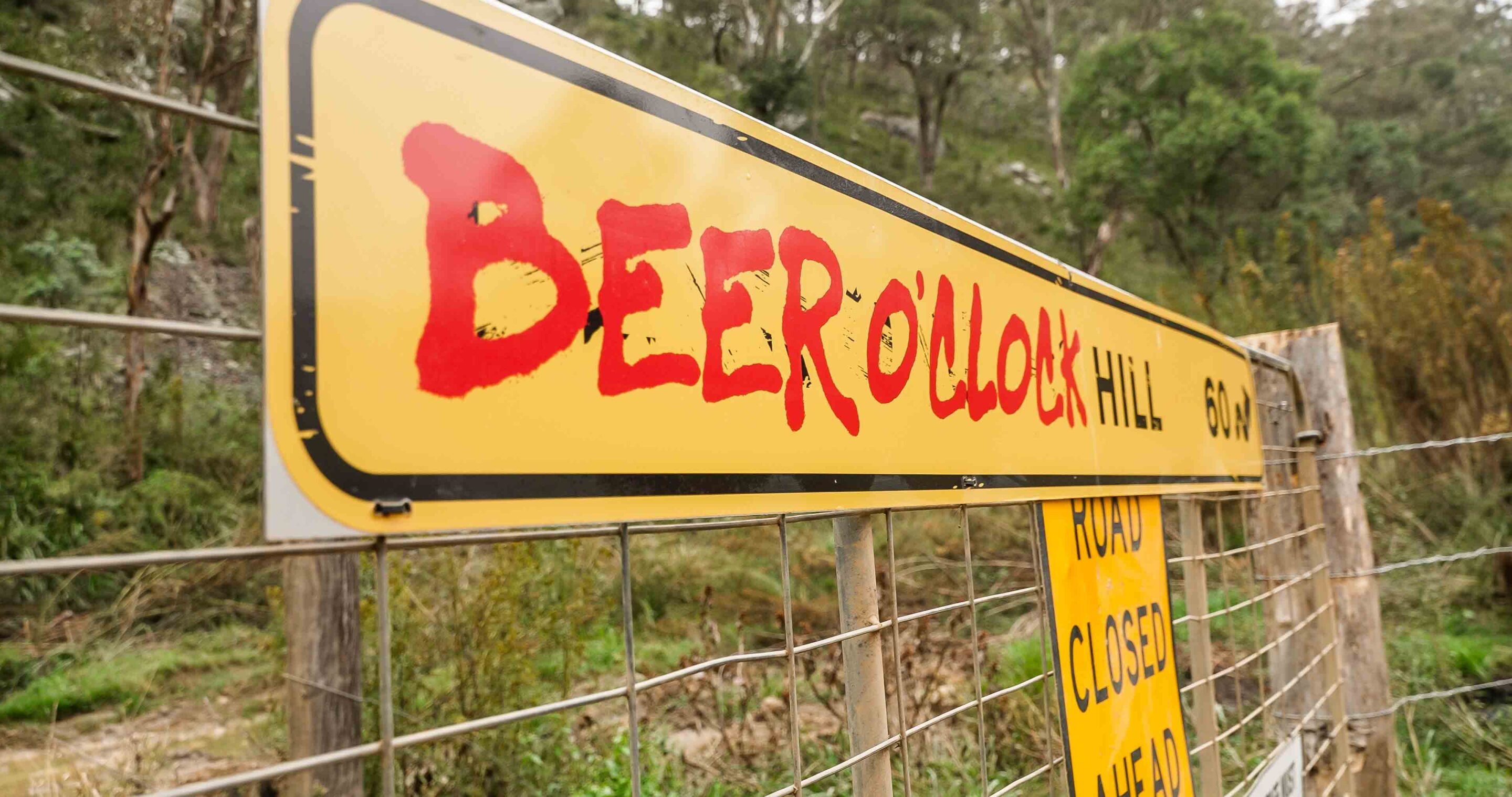
In addition, the Cannon XSR became the second full production-spec vehicle ever to officially conquer Beer O’Clock Hill – following the INEOS Grenadier. The Cannon XSR is powered by a 2.4-litre single-turbo diesel engine, producing 135kW and 480Nm and paired with a nine-speed automatic transmission.
“Successfully conquering Beer O’Clock Hill is no small feat. Many try, few succeed,” said Steve Maciver, Head of Marketing and Communications at GWM Australia. “For GWM to take multiple vehicles across different powertrains – including the new PHEV – to the summit speaks volumes about the strength, technology and real-world engineering behind our 4WD line-up. We’ve always known what our vehicles are capable of, but this achievement doesn’t just back up the promise, it delivers the proof.”
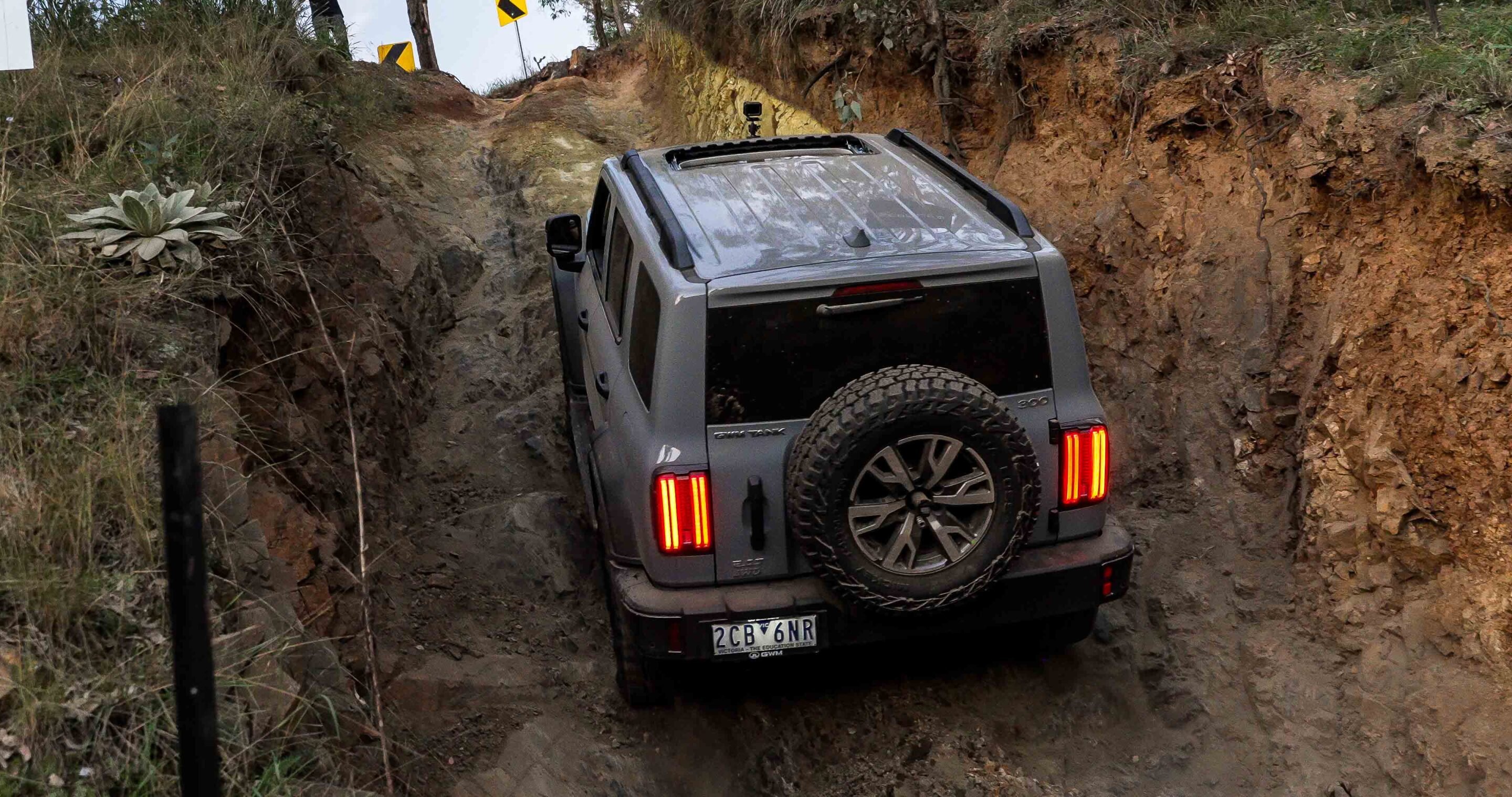
Located within the Springs 4×4 Adventure Park in Queensland, the technically demanding 100-metre ascent features gradients of up to 50 degrees, three separate rock steps, and a difficult rock ledge as steerers approach the summit.
It’s a climb that has caused plenty of vehicular damage over years, according to the park’s owner, Lucas Bree: “I reckon Beer O’Clock Hill has caused hundreds of thousands of dollars in vehicle damage over the years.
“[It has] shut down some of the most heavily modified rigs I’ve seen, so watching showroom-spec GWM vehicles, including a plug-in hybrid, make it to the top has completely changed my view of the brand,” Bree said.
Both the GWM Cannon Alpha plug-in hybrid (PHEV) and the diesel-powered Tank 300 have been awarded five-star ANCAP safety ratings, following updated assessments released by the independent vehicle safety authority.
The five-star ratings come after a review process in which GWM submitted extra technical data to ANCAP to demonstrate its new variants matched the safety performance of previously tested models.
ANCAP confirmed the new scores are extensions of existing ratings, based on supplementary analysis and engineering data. It’s a common step when manufacturers introduce new drivetrain variants or trim levels after an initial safety assessment.
“These latest safety ratings build on GWM’s consistent record of strong ANCAP results and underscore the brand’s commitment to the highest safety standards – delivering confidence and peace of mind to our customers,” said Steve Maciver, GWM’s Head of Marketing and Communications.
The Cannon Alpha PHEV scored:
- 84% for adult occupant protection
- 93% for child occupant protection
- 82% for vulnerable road user protection
- 81% for safety assist technologies
The Tank 300 diesel variant recorded similar results:
- 88% for adult occupant protection
- 89% for child occupant protection
- 81% for vulnerable road user protection
- 85% for safety assist
The Cannon Alpha PHEV – positioned as a direct rival to the BYD Shark – was introduced to the Australian market in April 2025, with prices starting from $63,990 drive-away.
The diesel-powered Tank 300 diesel officially debuted in March 2025, with pricing starting at $47,990 drive-away for the Lux variant and $51,990 for the Ultra. The diesel variant is powered by a 145kW/480Nm 2.4-litre four-cylinder turbocharged engine, paired with a nine-speed automatic transmission and part-time 4WD system.
Just last week GWM updated the Tank for 2025, increasing the towing and payload capacities of both its petrol and hybrid variants. The Chinese marque also axed the Tank 300 Lux grade, in both petrol and hybrid configurations.
This culling streamlined the Tank 300’s Australian line-up to just four variants: the Lux (diesel); and the Ultra (petrol, diesel and hybrid).
Toyota has added a new range-topping variant to its local Tundra line-up, with the Platinum joining the Limited in dealerships across the country.
On sale now, the Tundra Platinum is listed at $172,990, a steep $17,000 increase over the now “base-spec” Tundra Limited which retails for $155,990 and first arrived in November 2024. It’s a heavy whack to the hip pocket, but for that extra coin buyers are treated to a suite of interior and exterior additions.
Notably, the Platinum raises the stakes inside the cabin with new-look ‘blue and black’ genuine leather trim; 10-way power adjustment for the front passenger; four-way power adjustment and massaging function for the front seats; heating and ventilation for the outboard rear seats; power steering column adjustment; a heated steering wheel; and a 10.9-inch head-up display.
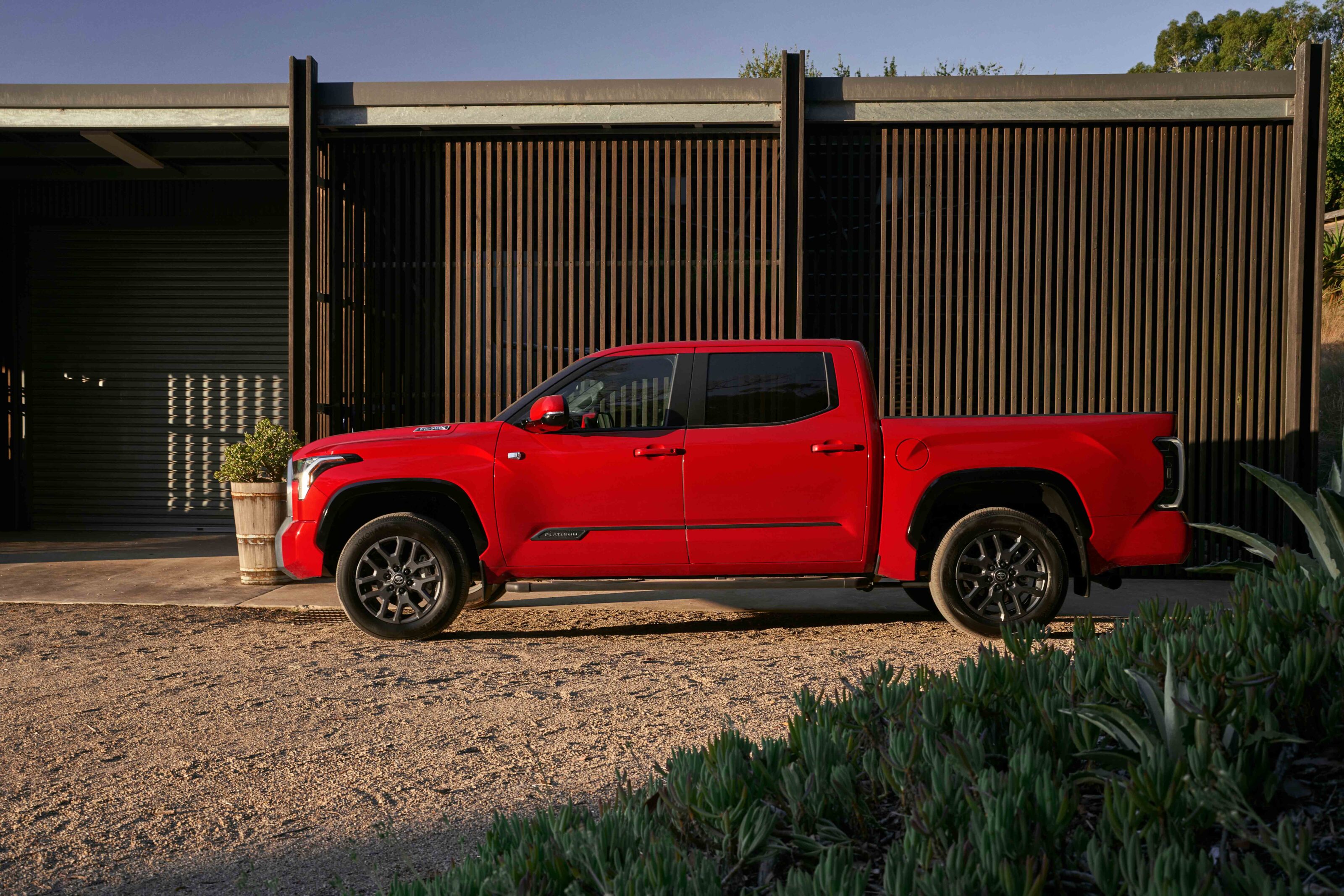
The Tundra Limited features black synthetic leather upholstery; eight-way power adjustment; two-way power lumbar adjustment; and heating and ventilation for just the front seats. Both grades feature a giant 14-inch touchscreen; a 12-speaker JBL sound system; the full suite of Toyota Safety Sense driver assistance technologies; and cavernous interior space.
“When we first proposed our Tundra program to locally re-engineer the US-built full size pick-up to right-hand drive, we knew it was not going to be an easy process, given Toyota had never done anything like it anywhere else in the world,” said Sean Hanley, Toyota Australia Vice President Sales, Marketing and Franchise Operations.
“But we knew, working with our partners at Walkinshaw, that we could achieve full Toyota-quality standards and the two-model line-up that we now have is testimony to that.
“The Tundra remains a niche product in our line-up but for those Australians that desire the size, power and performance of a full-size pick-up to meet their work or lifestyle needs, we are proud to say we can offer them a premium product built to the highest standards,” he said.
Converted in collaboration with Walkinshaw Automotive Group, the Tundra measures 5955mm long, 2040mm wide, and has a wheelbase of 3700mm. Both grades offer a braked towing capacity of 4500kg, as well as two towing modes, a manual trailer brake controller with 10 selectable adjustments, and a trailer back-up guide.
Both grades also utilise an i-FORCE MAX powertrain that combines a 290kW/649Nm 3.5-litre twin turbo V6 petrol engine with a 36kW/250Nm electric motor, to deliver peak performance of 326kW and 790Nm. This runs through a 10-speed automatic transmission and part-time 4WD system with a dual-range transfer case. The Tundra is built on the same TNGA-F ladder frame as per the Prado and 300 Series.
The Tundra Limited and Platinum full-size pickups are on sale.
Build Your Dreams (BYD) made big waves late last year when it announced and showed its Shark 6 midsize AWD ute. Not only was the Shark the first PHEV-powered vehicle in the ute segment but it promised stunning performance at a stunning launch price of $57,000.
Stunning because $57k barely gets you into a Ranger XLS or HiLux SR5, and the Shark comes with much more standard equipment than either of those two market leaders.
The company backed up the fanfare selling a tad more than 2000 Sharks in its first month on sale (February ’25), outselling ever-popular utes like the Isuzu D-Max, Mitsubishi Triton and Nissan Navara. It will be interesting to see if BYD can keep the momentum rolling on, and for how long it can maintain the current price point.
Early adopters that jumped in to get a Shark shouldn’t be disappointed in their purchase as they have a large, efficient, extremely well equipped ute that is going to tick all the boxes for many buyers. In its single specification, the Shark 6 includes features and interior finishes that are only available on top-spec 4×4 utes from other manufacturers… and at a considerably higher price than $57k.
JUMP AHEAD
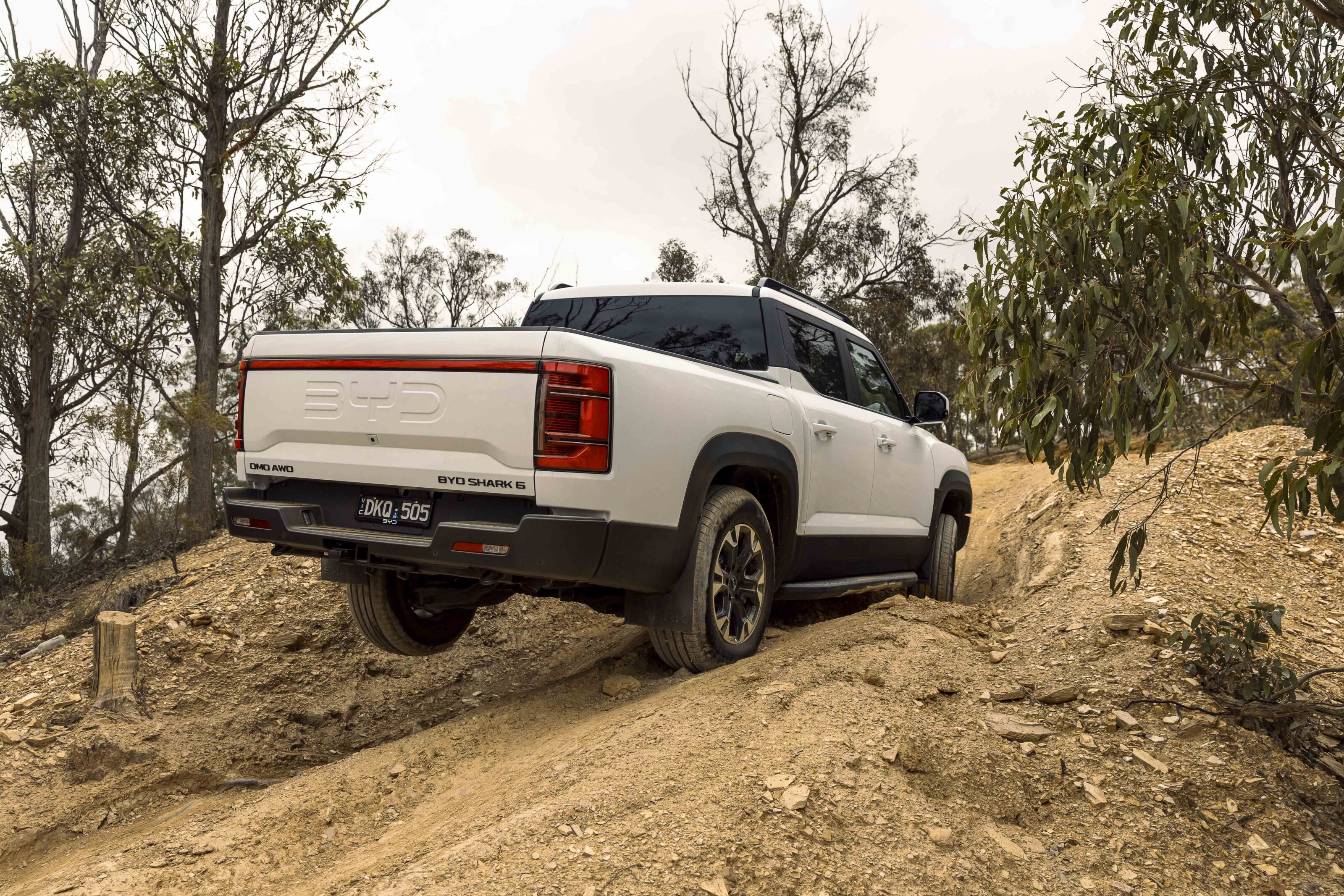
What does it get?
BYD is a Chinese company that builds and sells more EVs in its homeland than almost all of its competitors put together. It’s well established in the EV market and is spreading globally quicker than the spicy cough, and it seeks that market domination wherever it sells cars.
The Shark 6 is BYD’s first ute and it’s targeted straight at the Australian market where such vehicles are so popular that they make up a large part of overall sales.
The Shark 6 is a familiar four-door cab on a separate ladder-frame chassis but that’s where the similarities to convention end. The suspension is independent at each corner using double wishbones and coil springs, and there is no low range in the drivetrain. In fact, there is no transfer case at all, nor any connection between the front and back wheels.
Size-wise, it’s at the bigger end of the midsize ute segment, closest to the Ford Ranger and VW Amarok in size, and the generous cabin space is well appreciated.
| BYD Shark | Ford Ranger (Sport V6) | |
|---|---|---|
| Length | 5457mm | 5370mm |
| Width | 1971mm | 2208mm |
| Height | 1925mm | 1886mm |
| Wheelbase | 3260mm | 3270mm |
| Wheel track | 1660mm | 1620mm |
Powertrain
Propulsion comes courtesy of a pair of electric motors – one at each the front and back axles, plus a petrol engine that can operate on the front axle when called for, but its primary use is charging the batteries that power the electric motors.
The ICE power unit is a 135kW/260Nm turbocharged 1.5-litre petrol engine and it is mounted longitudinally in the front of the vehicle along with a 130kW/330Nm electric motor. The motor powering the back wheels is totally isolated from the front. It makes 150kW and 340Nm and comes into effect when required either for traction or ultimate performance. That’s 321kW and 650Nm in total!
Most of the time it’s the electric motors driving the Shark 6 while the ICE maintains charge in the batteries, but the petrol engine cuts in at speeds above 70km/h and when full throttle is applied. Put your right foot down in the Shark and BYD claims it will dash from 0-100km/h in just 5.7 seconds, and we have no reason to question that – the Shark gets up and goes hard when you ask it to!
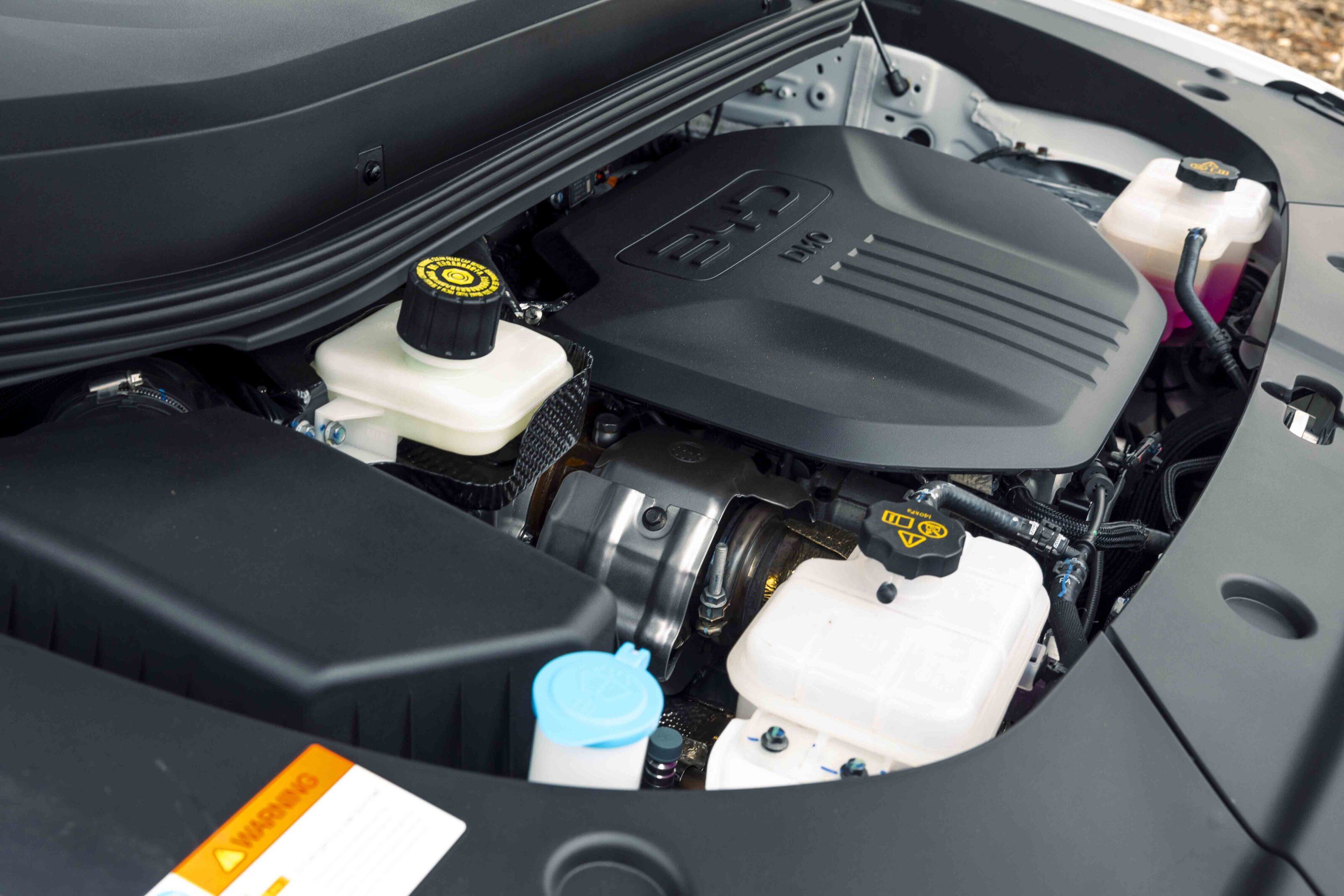
The battery is a 29.58kWh unit that sits low and flat in the chassis and BYD claims a range of up to 100km on a full charge using EV power only, depending on driving conditions.
The battery is charged by the ICE petrol engine, regenerative off-throttle charging or when plugged into a charger or home GPO. The petrol tank holds just 60 litres of fuel but with a 2.0L/100km official consumption rating, it gives close to 700km in touring range before you need to fill the tank or charge up from an external power source.
Driving the Shark around town it is mainly in full EV mode so it’s super quiet, and even when the petrol engine cuts in to charge the system you barely hear or notice it, resulting in very smooth and quiet propulsion. It’s only when you put your foot down that you notice the ICE powering the front wheels, but even then it is relatively quiet and smooth, particularly when compared to diesel-engine powered utes. These attributes, and the well-appointed interior, make the Shark 6 a very agreeable town ute.
Interior
The Shark 6’s cabin is spacious and reasonably well laid out. The finishes and touchpoints are soft, giving a feel of quality and luxury missing in most midsize utes which are more commercial-grade. The orange trim on the vents detracts from the quality appearance but that’s purely subjective; someone must like it.
The seats are covered in synthetic leather that has a genuine leather look and feel. The front seats are both heated and ventilated and have power adjustment. The rear seat has room for adult-size passengers with a reasonable recline on the backrest making it better for comfort than many other utes, especially on longer drives.
The centre infotainment screen is a huge 15.6-inch unit that sits in landscape mode in standard placement, but it can be rotated 90° to be viewed in portrait configuration if desired. However, if you wear polarised sunglasses the view of the screen might go dark for you in this upright mode. The landscape orientation is easier to view anyway.
The multimedia unit has DAB radio, Apple Carplay and Android Auto, and inbuilt satnav with free map updates for three years. The 12-speaker Dynaudio sound system adds to the premium feel of the cabin. Also included is dual-zone climate control and a wireless phone charging pad.
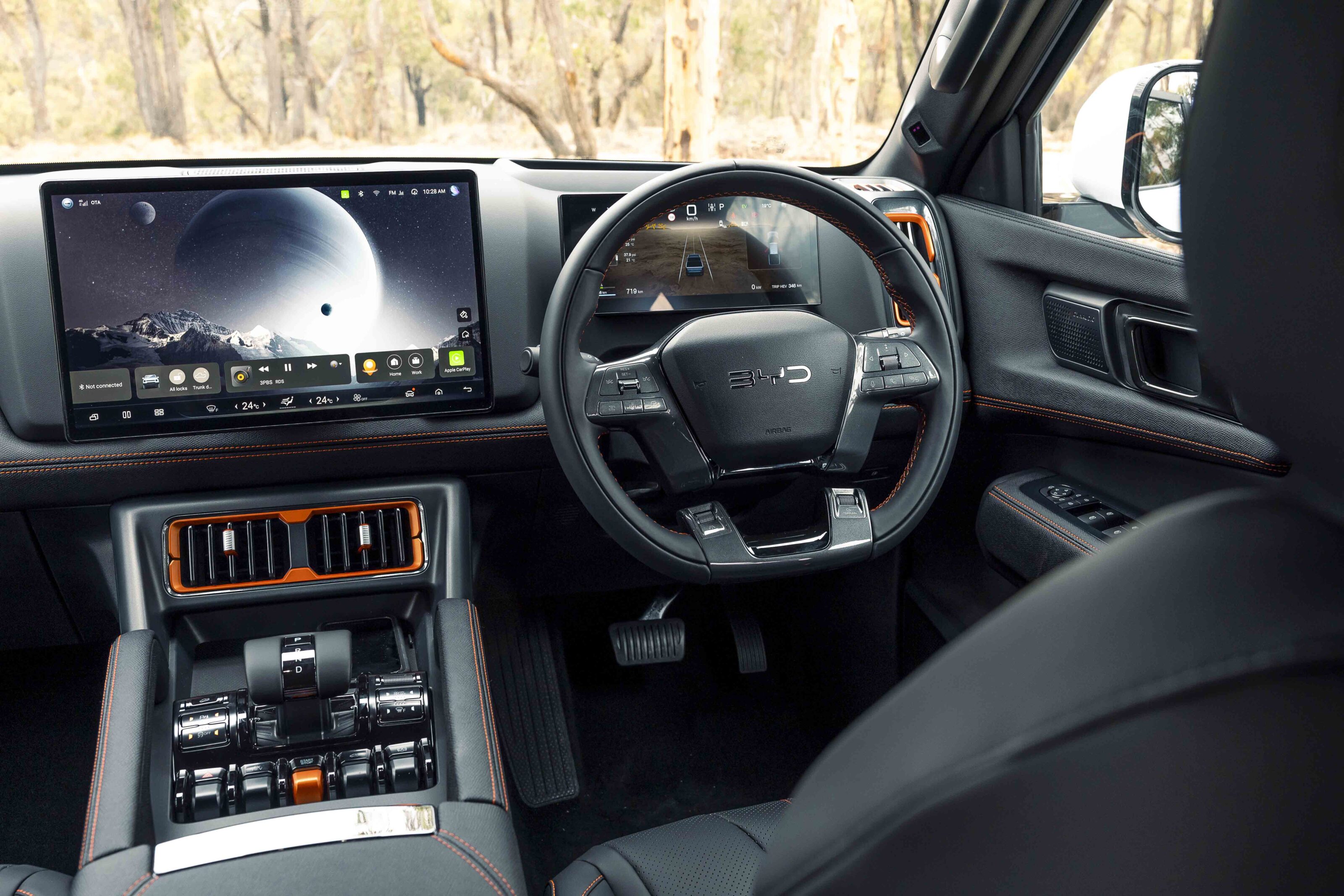
From a functionality point of view, it’s good to see that the temperature controls are always on the screen so you don’t need to go looking for them through menus, but with no physical dials or knobs, you can’t use them without taking your eyes off the road. There are physical rollers on the steering wheel and consoles for sound system volume control which is a plus for usability.
There are plenty of USB power outlets for both front and back seat passengers as well as a 230v/10A power outlet at the back of the console. There’s another three 230V/10A GPOs in the cargo tub for running tools and appliances off the battery pack.
The orange vents aside, the high levels of equipment and features gives the Shark’s cabin a premium feel that is lacking in the top models of the popular midsize utes, and is only found elsewhere in full-size American pickups costing twice as much as the BYD.
The quiet ride is aided by the use of Continental tyres but they are not well suited to off-road activity. Thankfully they are a common 265/65R18 size so you should be able to fit more durable alternatives. BYD offers the option of Toyo or BFG all-terrain tyres as well a choice of alloy wheel designs.
Safety
As you would expect of any all-new vehicle, the BYD Shark 6 features all the latest ADAS tech including a driver monitor with all the associated bells and whistles.
We were pleasantly surprised to find that the system was nowhere near as intrusive and annoying as similar systems in most other new vehicles. The warning chimes are subtle and not too offensive and the ADAS doesn’t constantly fight you at the steering wheel on freeways and backroads… but try and make a lane change without using an indicator (common practice in Melbourne) and the system lets you know it’s there and that it’s working.
On- and off-road performance
Not so smooth is the suspension which is very stiff and gives the Shark a firm ride on smooth roads and a rough ride on Melbourne’s woeful roads and highways.
One particular patch of potholes on exiting a roundabout rattled the Shark to such an extent that the whole cabin shook violently, leading me to wonder how it would feel once we got on a dirt road. I didn’t have to wait long as we soon hit the access road to our photography location; a well-groomed gravel road that has small corrugations in it. Again the Shark 6 shook violently with the scuttle shake you used to get in some convertible cars, but in this case it was felt through the whole passenger compartment.
I swapped into another 4×4 ute (standard suspension and tyres) and drove up the same road and while the corrugations could be felt it didn’t react and shake hard like the BYD did. With this in mind, I would have concerns about taking a BYD Shark 6 on standard suspension on any extended outback travel. A softer and more compliant suspension package would be warranted, and would improve the ride quality both on and off the road.
The shortcomings of the suspension also revealed themselves as the track deteriorated and the lack of suspension travel has it easily cocking wheels and losing traction. This in turn showed up the shortcomings of the drive system. After stopping on what could only be described as a gravel driveway with a slight incline, the Shark 6 wouldn’t advance off the mark, only spinning a single front tyre.
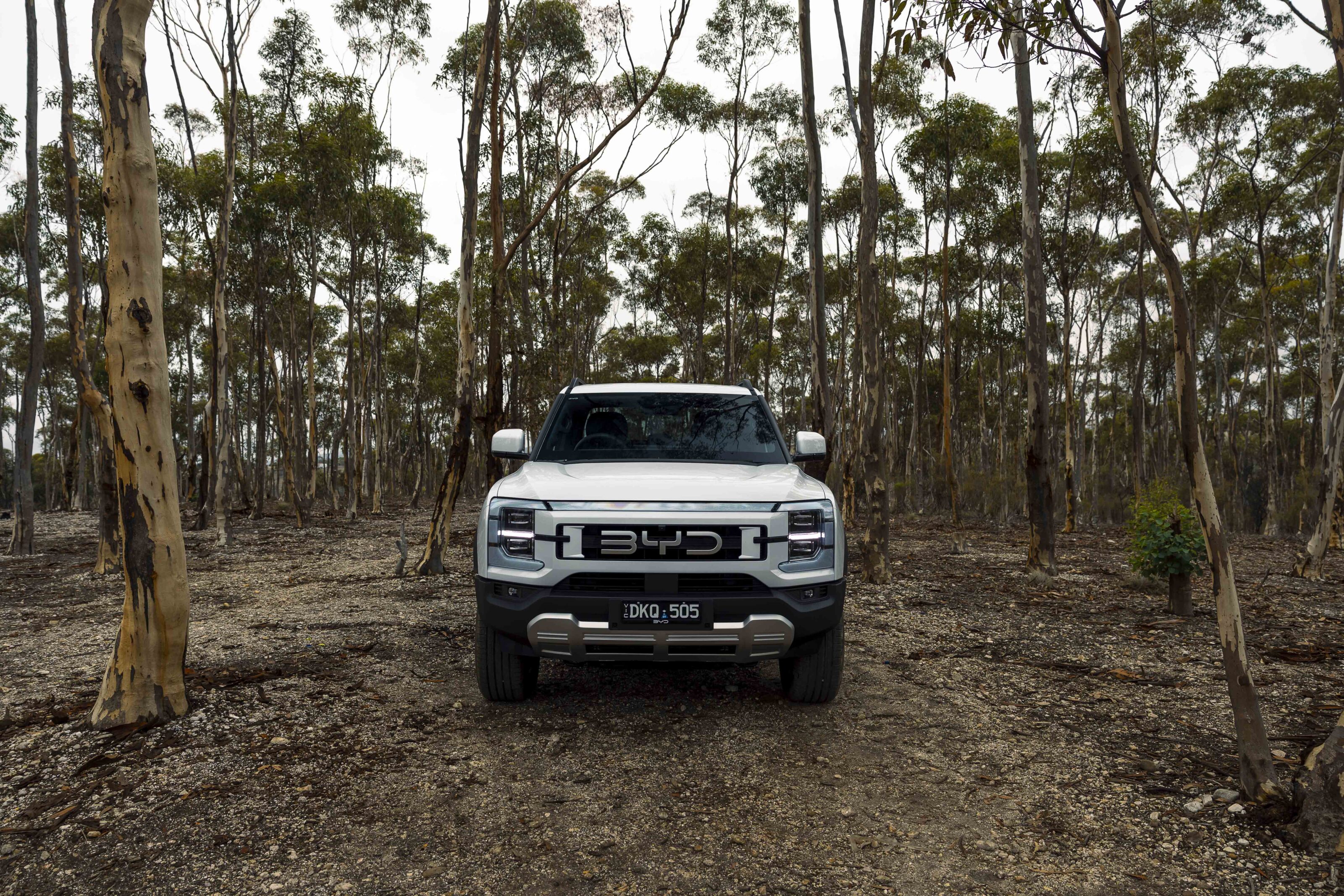
As described earlier, there is no mechanical connection between the front and rear wheels, only an electronic one. The Shark 6 does have multiple dive modes – Normal, Mud Land, Sand Land, Snow Land and Mountain Land. In the Normal mode, which you would expect to use on such a gravel track, the Shark 6 is essentially a front-wheel drive vehicle and it wasn’t until I selected one of the other modes that drive was applied to the rear wheels by its motor and the Shark 6 progressed.
It was no surprise that the Shark 6 failed to progress when pointed at a steeper rutted track when in Normal mode but playing with the modes did bring positive results. We found that Mountain Land mode worked the best and got the Shark 6 up the track… but it did so kicking and screaming. The electronics are slow to react and feel and sound a lot like the early ETC systems from Land Rover that came out in the Discovery Series 2 (update model without centre diff lock) and early Freelander models. It’s slow to react and noisy in doing so, resulting in excessive wheelspin and kicking up plenty of dust.
With its electric motor powering the rear wheels any sort of locker would probably come as a software update from BYD, but for owners looking to upfit their Shark 6 for specific usage, BYD has partnered with Ironman to develop a range of accessories. These must be purchased from BYD at the time of buying your Shark and they include a choice of front bumpers including a bull bar, roof racks, roller tonneau cover and a canopy.
With the exceptionally high sales of the Shark 6 in its first months on sale we expect other aftermarket equipment manufacturers to soon jump on board with gear for this ute.
Verdict
I expected better of the Shark 6 considering how ‘advanced’ it feels in many areas, and I was disappointed in its performance off sealed roads.
This is not an offroad 4×4 ute; I brought up these tractive deficiencies of the Shark 6 when we drove a pre-production prototype last year and BYD said it would be updated and addressed in the production model. The off-highway deficiencies aside, the BYD Shark 6 is an exceptional ute that brings new levels of efficiency, interior trim and design to the ute segment.
I said at the start that the Shark 6 represents a great first entry into the ute market, and that comment stands. Now we await to see how the brand seeks to address its deficiencies, or whether it prefers to leave the vehicle as simply a ripper town ute.
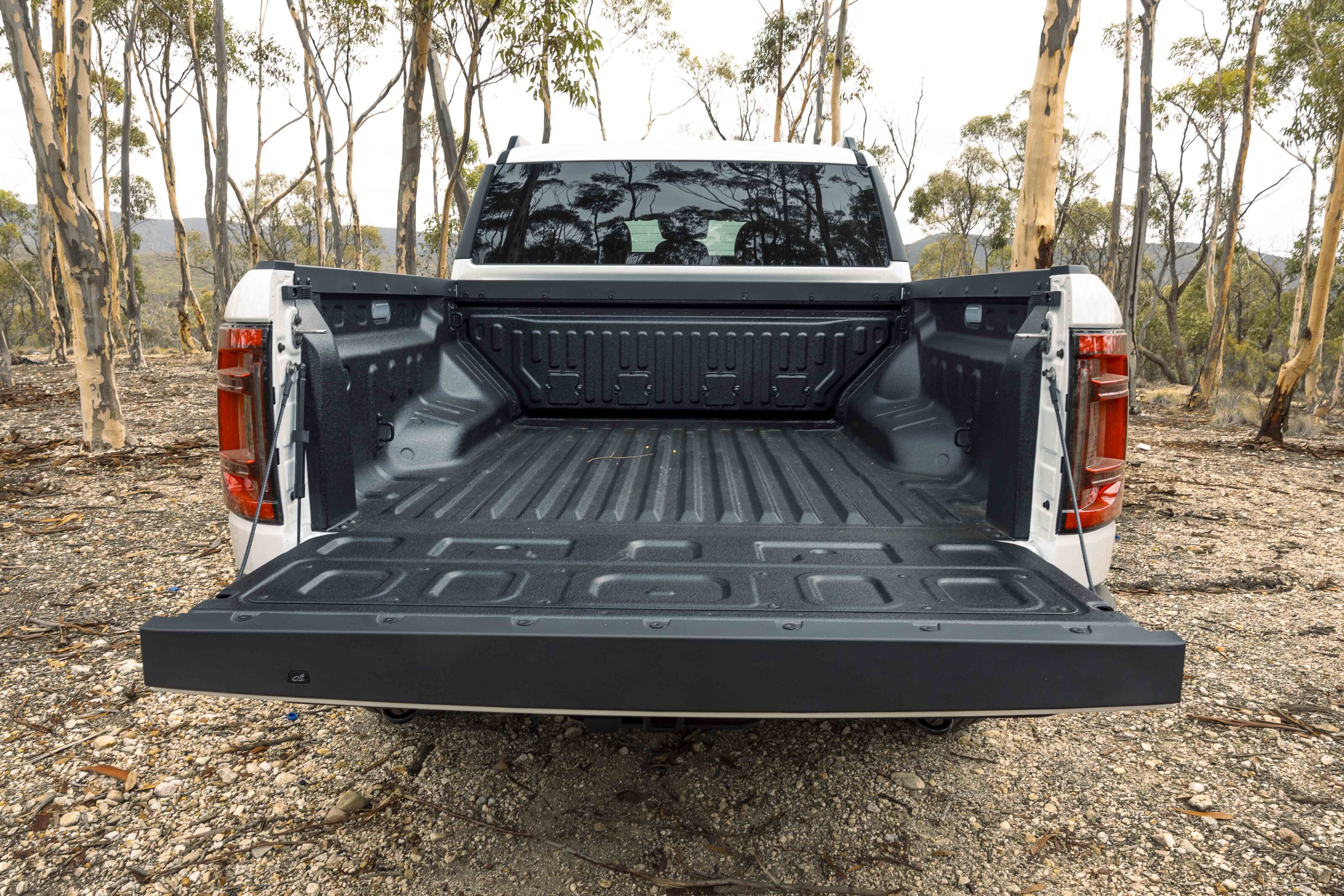
Specs
| Price | $57,000 |
|---|---|
| Engine | PHEV; turbocharged petrol engine with electric motors front and rear |
| Capacity | 1.5L |
| Max power | (ICE) 135kw, (EV) 130kw (front) 150kw rear |
| Max torque | (ICE) 260Nm, (EV) 310Nm front, 340Nm rear |
| 4×4 system | Individual between front and rear wheels |
| Construction | 4-door ute on ladder frame |
| Front suspension | Independent, double wishbones with coil springs |
| Rear suspension | Independent, double wishbones with coil springs |
| Tyres | 265/65R18 on alloy wheels |
| Kerb weight | 2710kg |
| GVM | 3500kg |
| GCM | 5750kg |
| Towing capacity | 2500kg |
| Payload | 790kg |
| Seats | 5 |
| Fuel tank | 60L |
| ADR fuel consumption | 2.0L/100km |
| Approach angle | 31 |
| Ramp-over angle | 17 |
| Departure angle | 19.3 |
| Ground clearance | 230mm |
| Wading depth | 700mm |
The BYD Shark 6 has earned a five-star ANCAP safety rating.
The PHEV – which launched in 2024 at a compelling price of $57,900 – excelled during testing in two key criteria: Adult Occupant and Child Occupant Protection, scoring 85 per cent and 87 per cent respectively. Plus, it received scores of 86 per cent (Safety Assist), and 74 per cent (Vulnerable Road User Protection) in the remaining key areas.
The Shark is equipped with dual frontal airbags, side chest and side head-protecting airbags, and a centre airbag. Plus it’s loaded with plenty of advanced safety tech 👇
| Safety features | |
|---|---|
| 360u00b0 camera | Front and rear parking sensors |
| Intelligent power brake system | Hydraulic Brake Assist (HBA) |
| Electronic Brake force Distribution (EBD) | Hill Hold Control (HHC) |
| Controller Deceleration Parking (CDP) | Vehicle Dynamic Control (VDC) |
| Hill Descent Control (HDC) | Driver Fatigue Monitor System (DFM) |
| Adaptive Cruise Control (ACC) | Automatic Emergency Braking (AEB) |
| Lane Departure Warning (LDW) | Lane Departure Prevention (LDP) |
| Emergency Lane Keeping Assist (ELKA) | Front Collision Warning (FCW) |
| Intelligent Cruise Control (ICC) | Rear Collision Warning (RCW) |
| Trac Sign Recognition (TSR) | Intelligent Speed Limit Information (ISLI) |
| Intelligent Speed Limit Control (ISLC) | Front Cross Trac Alert (FCTA) |
| Front Cross Trac Brake (FCTB) | Rear Cross Trac Alert (RCTA) |
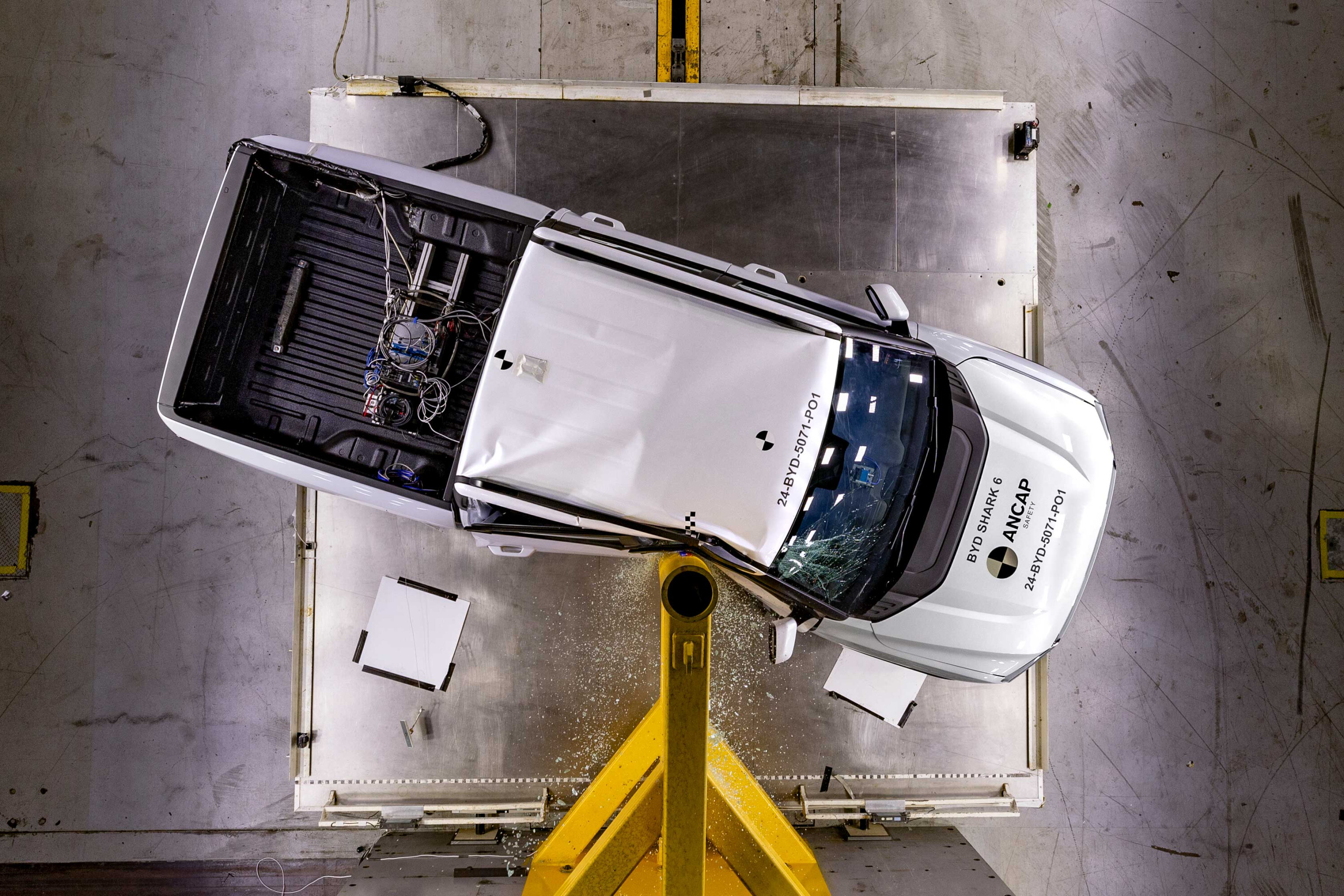
The Shark received a score of 34.37 out of 40 in the Adult Occupant Protection test; 43 out of 49 for the Child Occupant Protection test; 47.14 out of 63 in the Vulnerable Road User Protection test; and 15.59 out of 18 in the Safety Assist test.
“With five of BYD’s current local models having now earned top ANCAP safety ratings, it’s evident that new manufacturers are prioritising safety as they enter the market to align with consumer demands,” said ANCAP CEO Carla Hoorweg.
“Following the recently rated GWM Cannon Alpha hybrid ute, we expect to see an increase in electrified options in the utility space. And so far, they’re meeting the mark.
“For fleets looking to electrify their light commercial ute range, the SHARK 6 presents a new five-star plug-in hybrid option,” Hoorweg added.
However, the testing did reveal a safety concern. Due to the vehicle’s size, weight and front-end design, ANCAP says the Shark “poses a higher risk to occupants of oncoming vehicles”. It was penalised accordingly. Click HERE for the full ANCAP safety report.
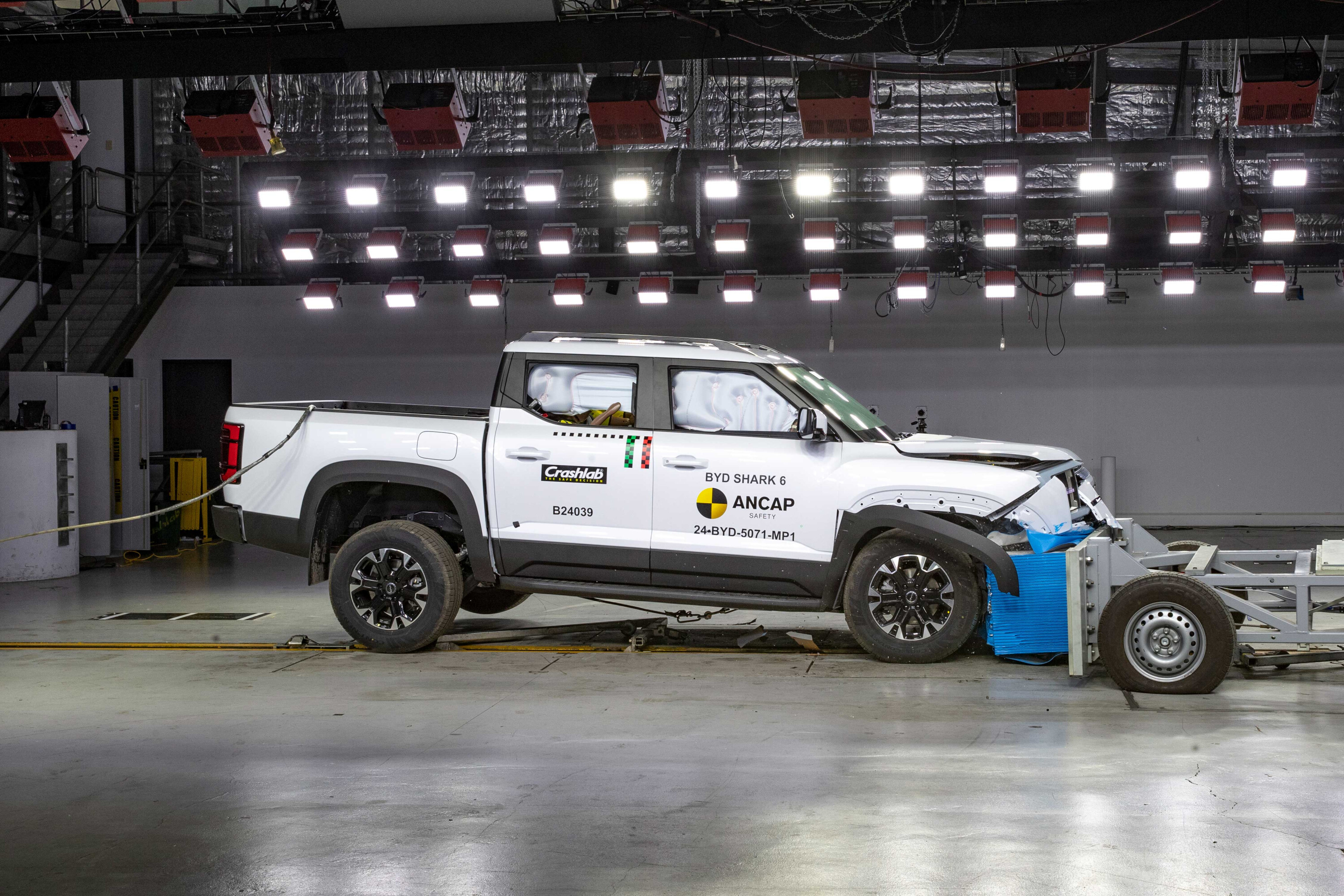
The Shark quickly gained popularity in Australia, with around 4000 orders placed within a month of its pricing announcement at the end of 2024.
Powered by BYD’s DM-O technology, the Shark 6 combines a 1.5-litre turbocharged petrol engine with dual electric motors, accelerating from 0-100 km/h in 5.7 seconds. It also features a 29.58kWh Blade Battery, providing 100km of pure electric range and a total range of 800km. However, its towing capacity of 2500kg falls short of the 3500kg industry standard, which could impact its long-term appeal.
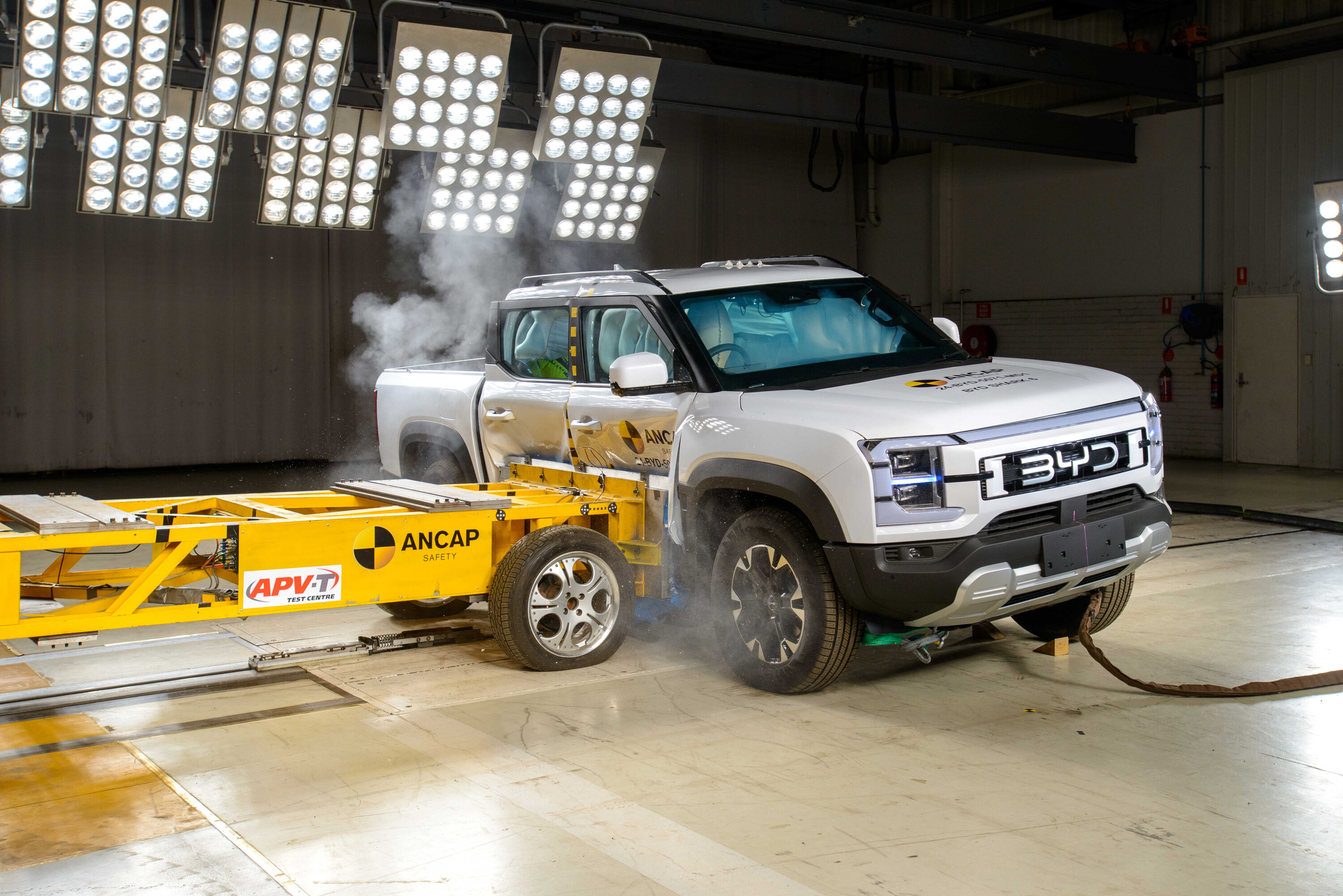
Inside, the Shark 6 offers premium features, including a leather-wrapped steering wheel, 10.25-inch LCD screen, wireless Apple CarPlay and Android Auto, a 15.6-inch rotating screen, and heated/ventilated front seats with power adjustments.
In collaboration with Ironman 4×4, BYD also offers a range of Australian-designed aftermarket accessories for the Shark 6, such as bull bars, roof racks, and tonneau covers. These accessories can be added at the time of purchase and are backed by BYD’s six-year, 150,000km warranty.
2025 BYD Shark specs
| Dimensions | |
|---|---|
| Overall length | 5457mm |
| Overall width | 1971mm |
| Overall height | 1925mm |
| Wheel track (front and rear) | 1660mm |
| Wheelbase | 2920mm |
| Minimum turning radiusu00a0 | 5.50m |
| Tray capacity | 1200L |
| Kerb weight | 2710kg |
| GVM | 3500kg |
| Seating capacity | 5 |
| Off-road dimensions | |
|---|---|
| Approach angle | 31.0 |
| Departure angle | 19.3 |
| Ramp-over angle | 17.0 |
| Ground clearance | 230mm |
| Maximum wading depth | 700mm |
| Powertrain | |
|---|---|
| Drivetrain | AWD |
| Front motor type | Permanent magnet, synchronous motor |
| Front motor maximum power | 170kW |
| Front motor maximum torque | 310Nm |
| Rear motor type | Permanent magnet, synchronous motor |
| Rear motor maximum power | 150kW |
| Rear motor maximum torque | 340Nm |
| Engine type | Hybrid special longitudinal 1.5Tu00a0 |
| Engine maximum power | 135kW |
| Engine maximum torque | 260Nm |
| Maximum power | 321kW |
| Maximum torque | 650Nm |
| Fuel tank capacity | 60L |
| Combined fuel consumption | 7.9L/100km |
| Combined range | 800km |
| Performance | |
|---|---|
| Acceleration (0-100km/h) | 5.7 seconds |
| Electric range | 100km |
| Battery type | BYD Bladeu00a0 |
| Battery capacity | 29.58kWh |
| CO2 emissions | 46g/km |
| Combined fuel consumption | 2.0L/100km |
| Energy consumption | 212Wh/km |
| Chassis | |
|---|---|
| Front suspension | Double wishbone |
| Rear suspension | Double wishbone |
| Front/Rear disc brakes | Ventilated discs |
| Wheel type | Alloy |
| Tyre size | 265/65 R18 |
| Wheel size | 18 x 8J |
| Towing | |
|---|---|
| Braked capacity | 2500kg |
| Unbraked capacity | 750kg |
In the 24 hours since pricing was released for the all-new Shark, more than 2000 orders have already been placed by the public.
In fact, the surge in traffic to the BYD website caused it to temporarily crash, as order books opened with an introductory price of $57,900 (plus on-road costs).
The Shark 6 will be exclusively distributed by Australian company EVDirect, with the company’s Managing Director, Luke Todd, expressing his surprise at the unprecedented level of interest.
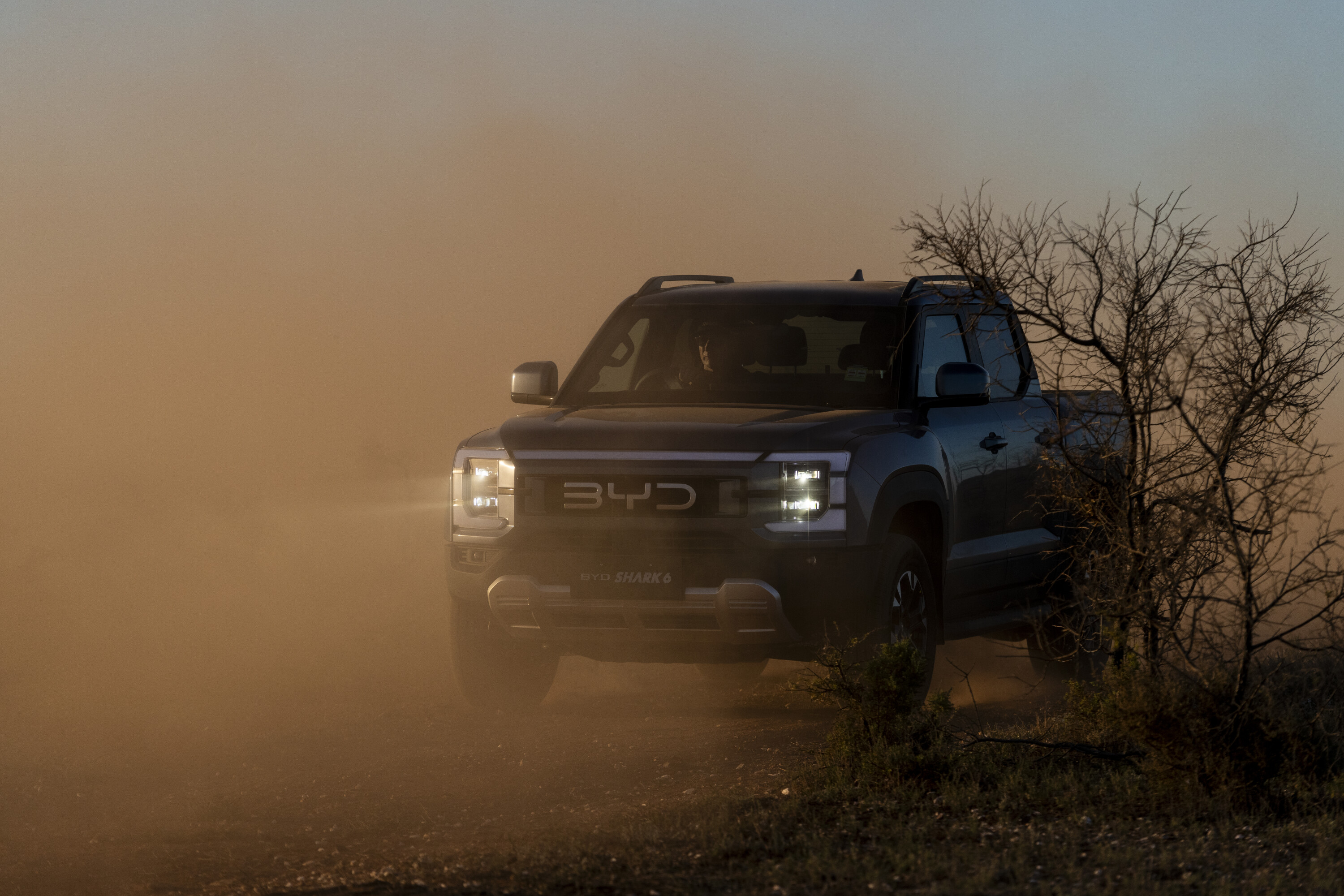
“We knew the market was wanting a vehicle of this calibre, but to see so many orders so quickly has taken us by surprise,” Todd said. “It is simply in a different league to anything on the market, and at the price of $57,900 (plus on-road costs) the value for money speaks for itself.”
The Shark 6 features BYD’s DM-O technology, combining a 1.5-litre turbocharged petrol engine with dual electric motors for a total output of 321kW and 650Nm. Plus, a 29.58kWh Blade Battery provides 100km of electric range and a total range of up to 800km.
The Shark’s interior includes a leather-wrapped steering wheel, a 10.25-inch LCD screen, imitation leather seats, wireless connectivity, a 15.6-inch rotating screen, and heated and ventilated front seats with power adjustments. Full specs here ?
Ironman 4×4 has also partnered with BYD’s local distributor, EVDirect, to create a selection of products for the Shark. These factory-backed accessories include bull bars, roof racks, tonneau covers and canopies.
Customer deliveries of the Shark are slated to begin in December.
Ford will showcase its Ranger PHEV in public for the first time in Australia, at the 2024 Mobility Live event.
Held at the Melbourne Convention and Exhibition Centre on October 30 and 31, the free event allows governments and fleets an opportunity to take a closer look at the future of electric commercial vehicles.
A limited-edition Ranger PHEV Stormtrak model will be on display, wearing an all-new Chill Grey exterior hue. It will debut beside an E-Transit Custom van, also exposed in public for the first time.
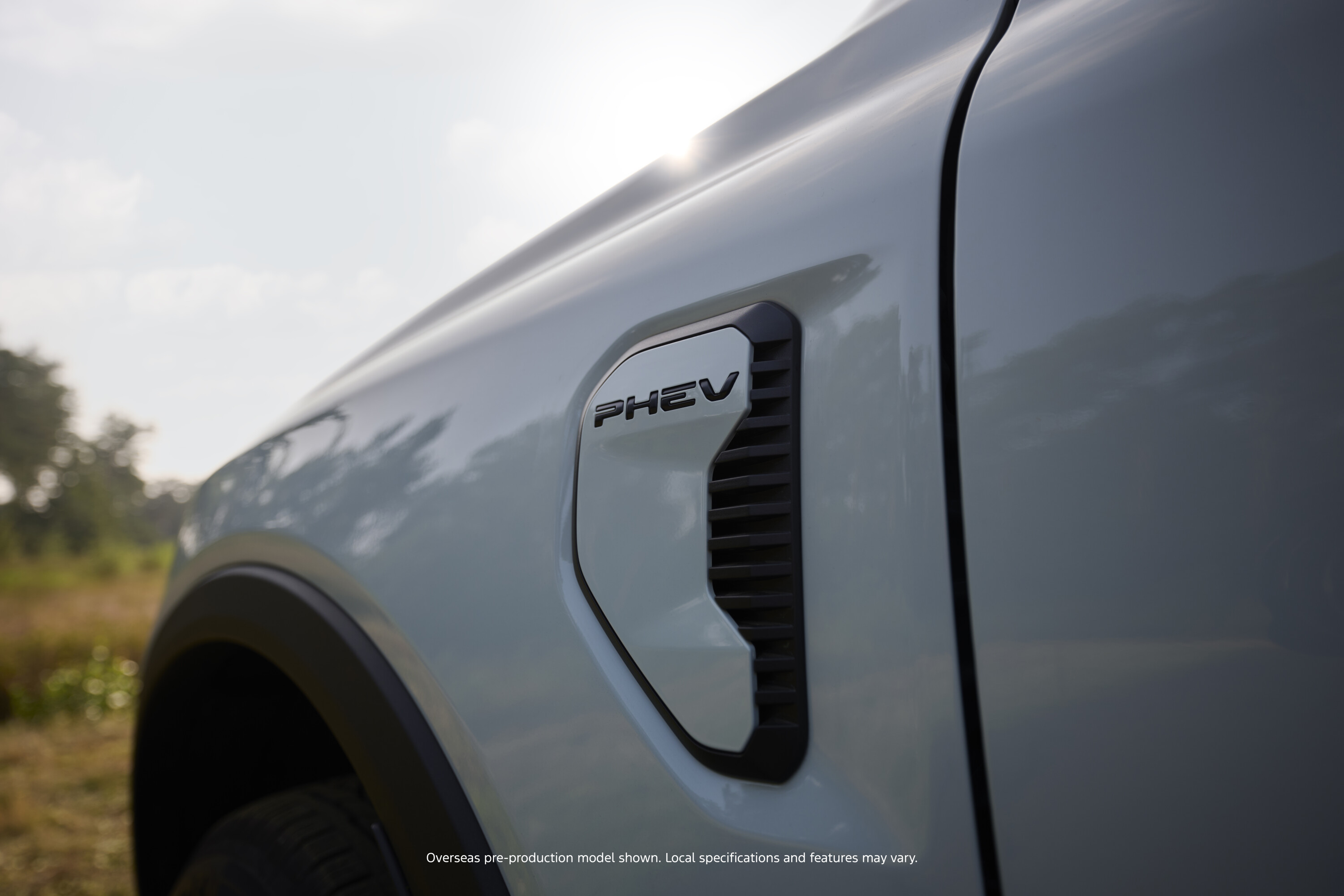
“It’s really important that fleets wanting to decarbonise have access to vehicles that allow them to continue doing their work without the need to compromise,” says Myles Hartley, General Manager of Electric Vehicles, Ford Australia.
“Both the Ranger PHEV and E-Transit Custom have all the capability that makes their nameplates legendary around the world, with the added benefit of an electrified powertrain.”
The PHEV powertrain will be offered with Wildtrak, Sport and XLT variants, along with the new Stormtrak launch edition that will be on display. The Stormtrak comes standard with a Flexible Rack System, Matrix LED headlights, Pro Trailer Backup Assist, a 360-degree camera, 18-inch alloy wheels, a honeycomb grille, fender vents, a stylish decal kit, and a premium cabin with a B&O sound system.
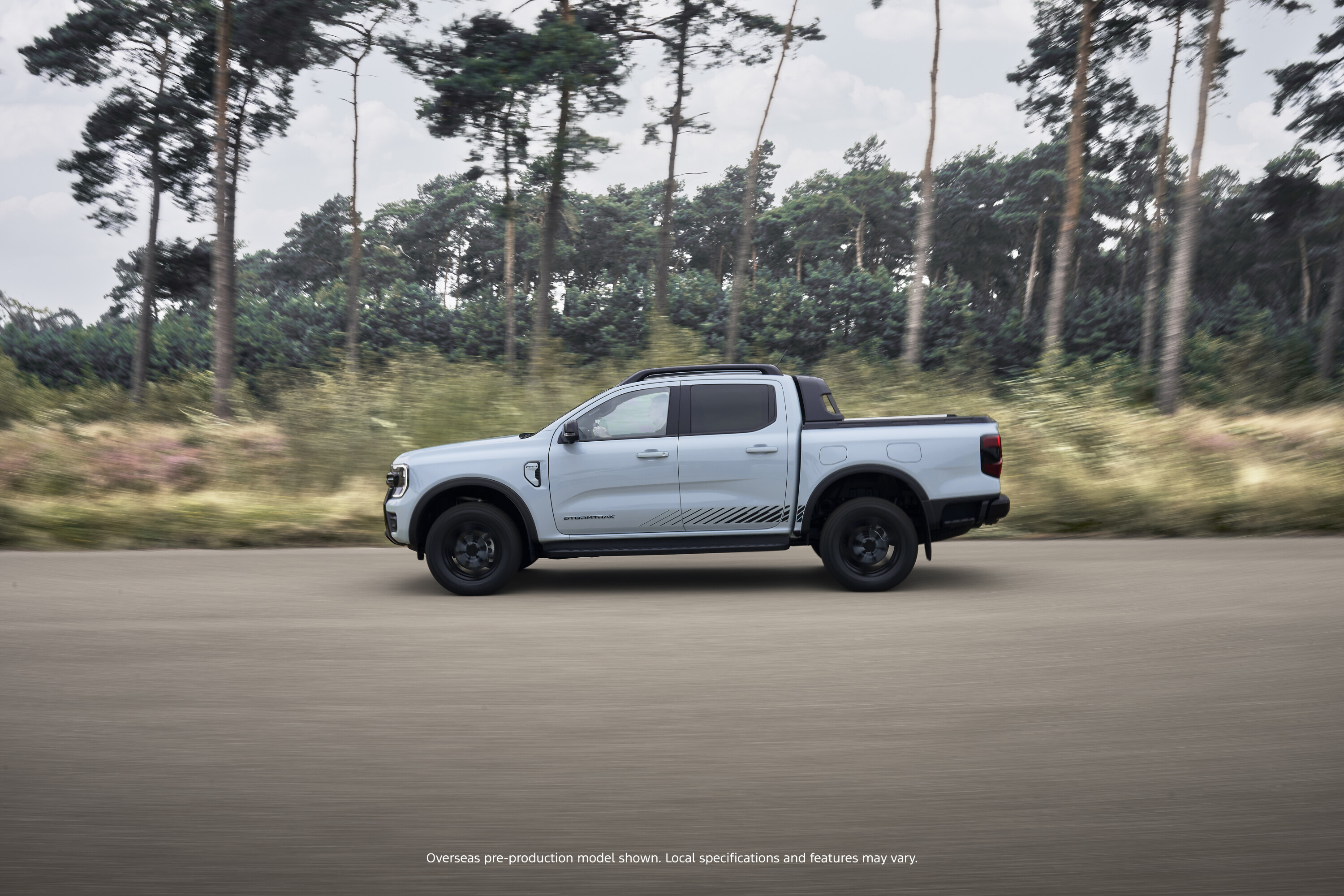
The PHEV powertrain combines a 2.3-litre turbocharged EcoBoost petrol engine with a 75kW electric motor and an 11.8kWh battery. Ford claims the PHEV can achieve over 45 km of electric-only range. A modular hybrid transmission (MHT) integrates the e-motor and separator clutch between the engine and 10-speed transmission, enabling the electric and internal combustion engine systems to work together or operate independently.